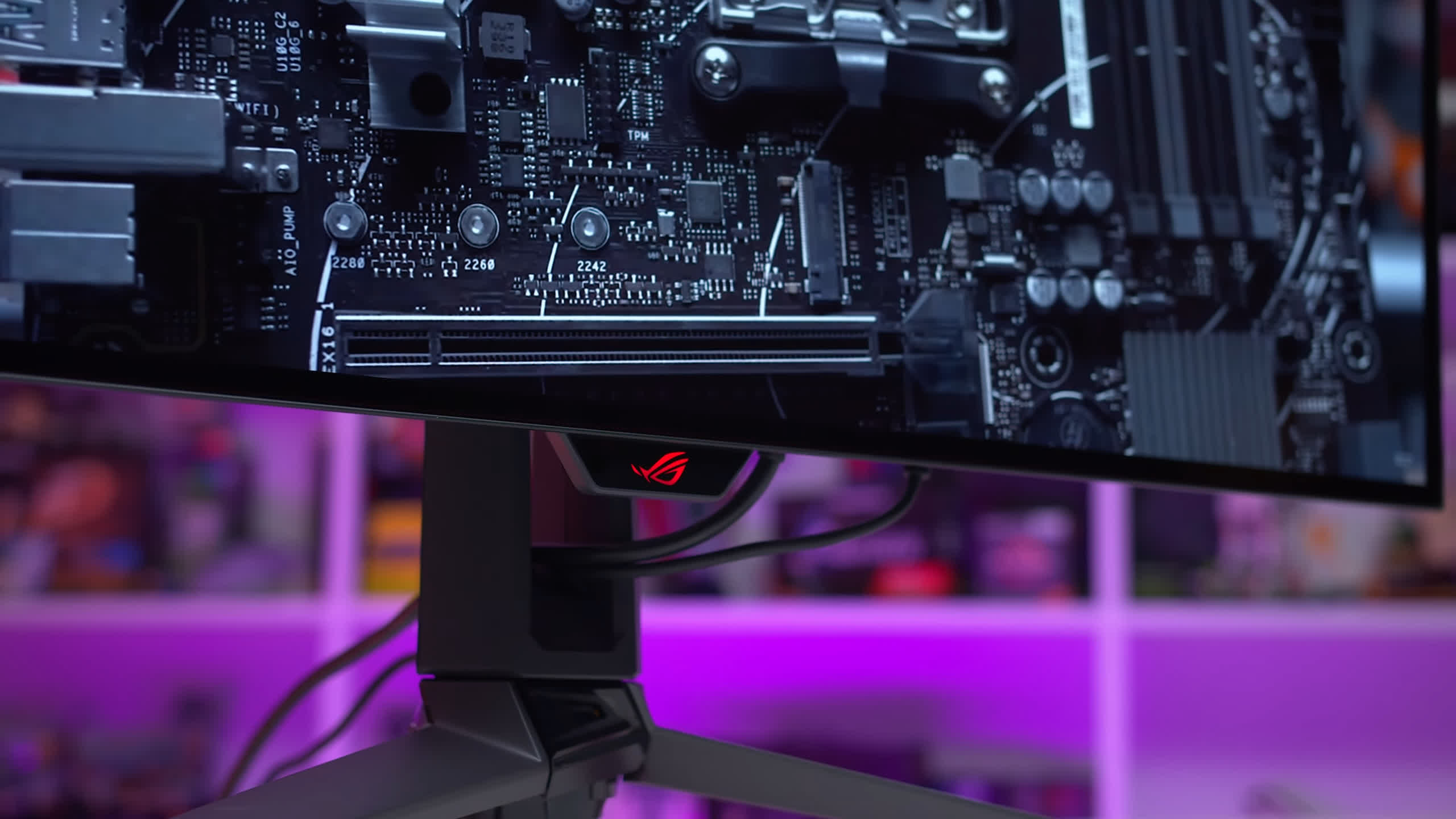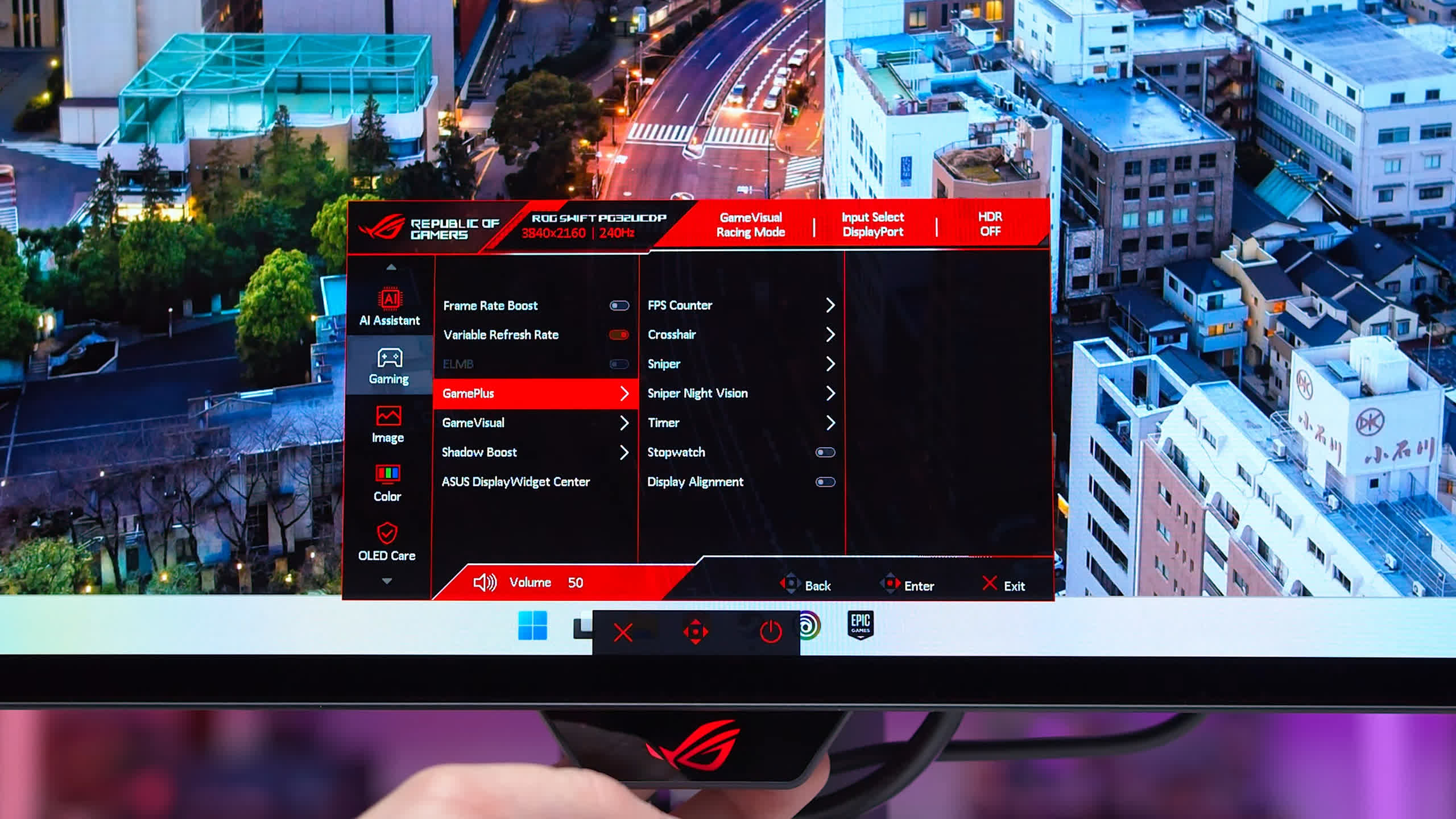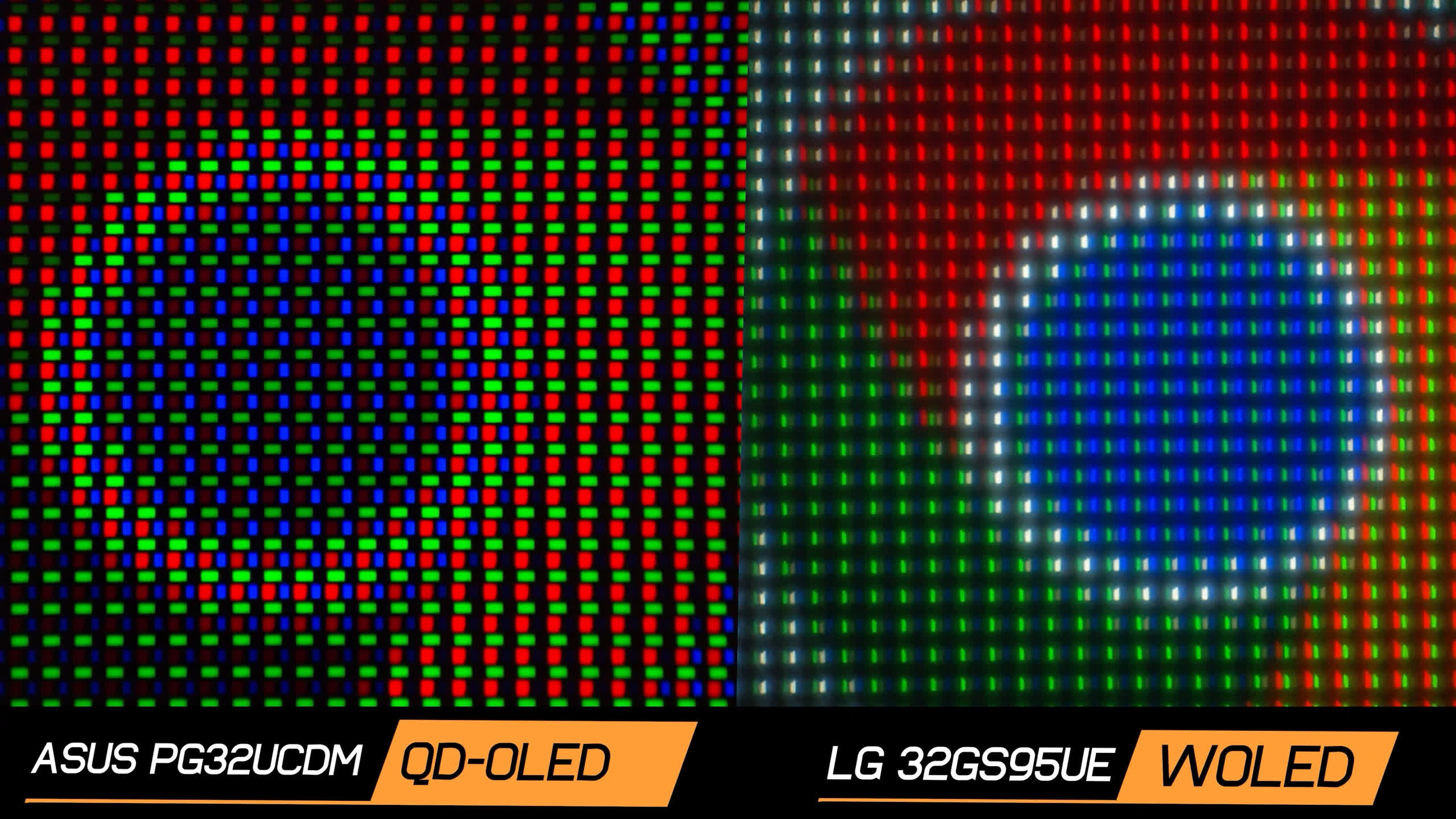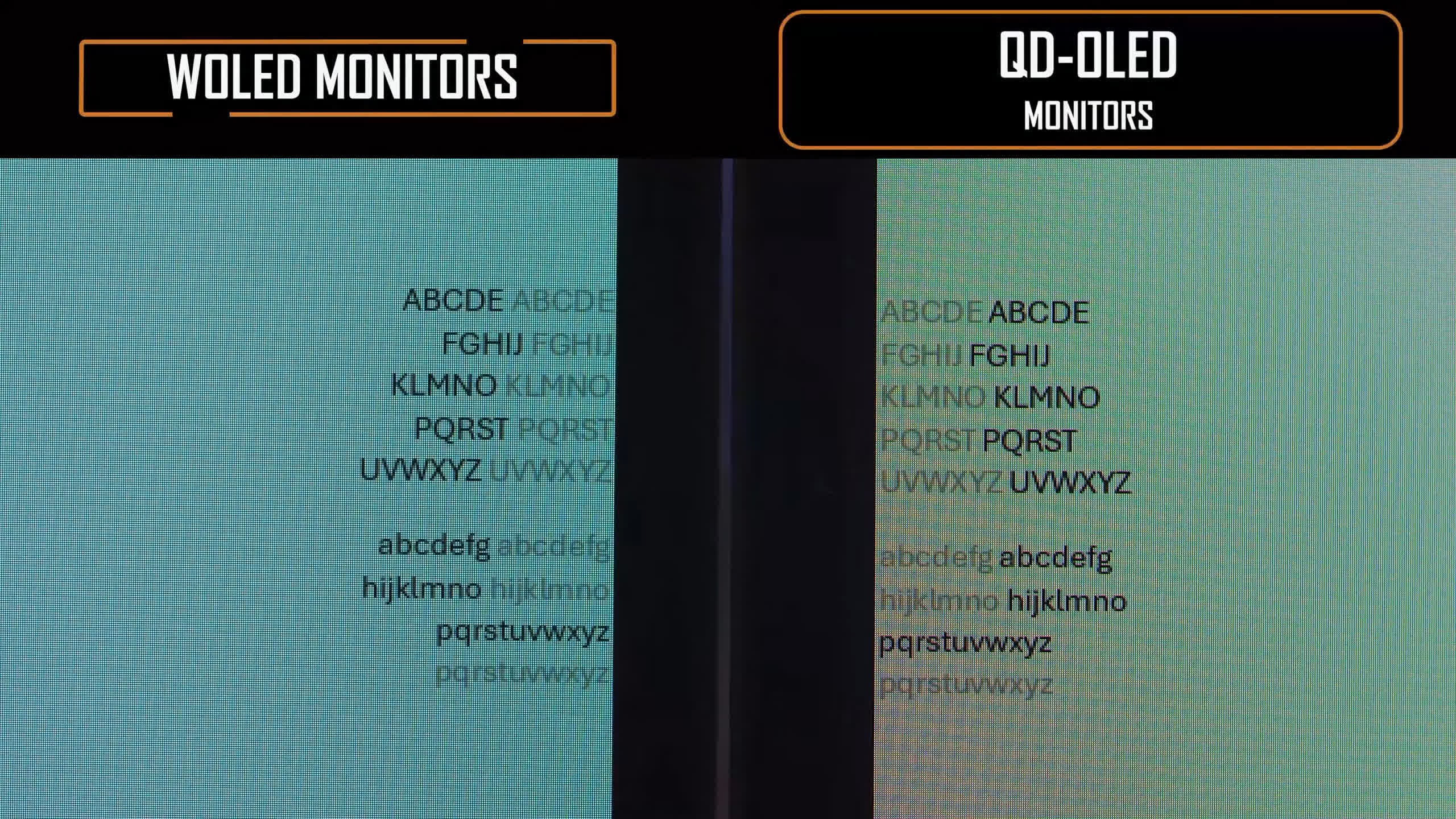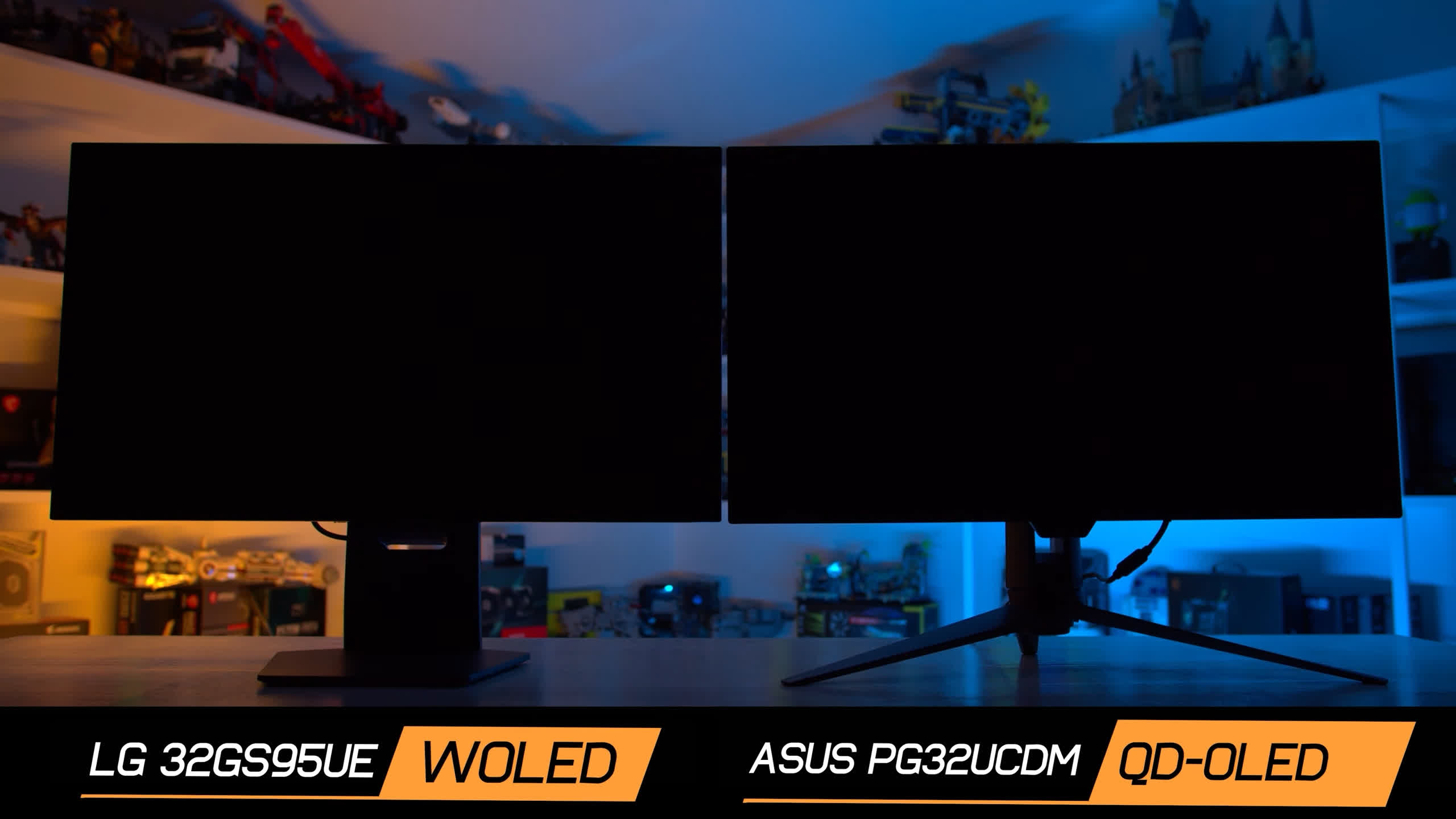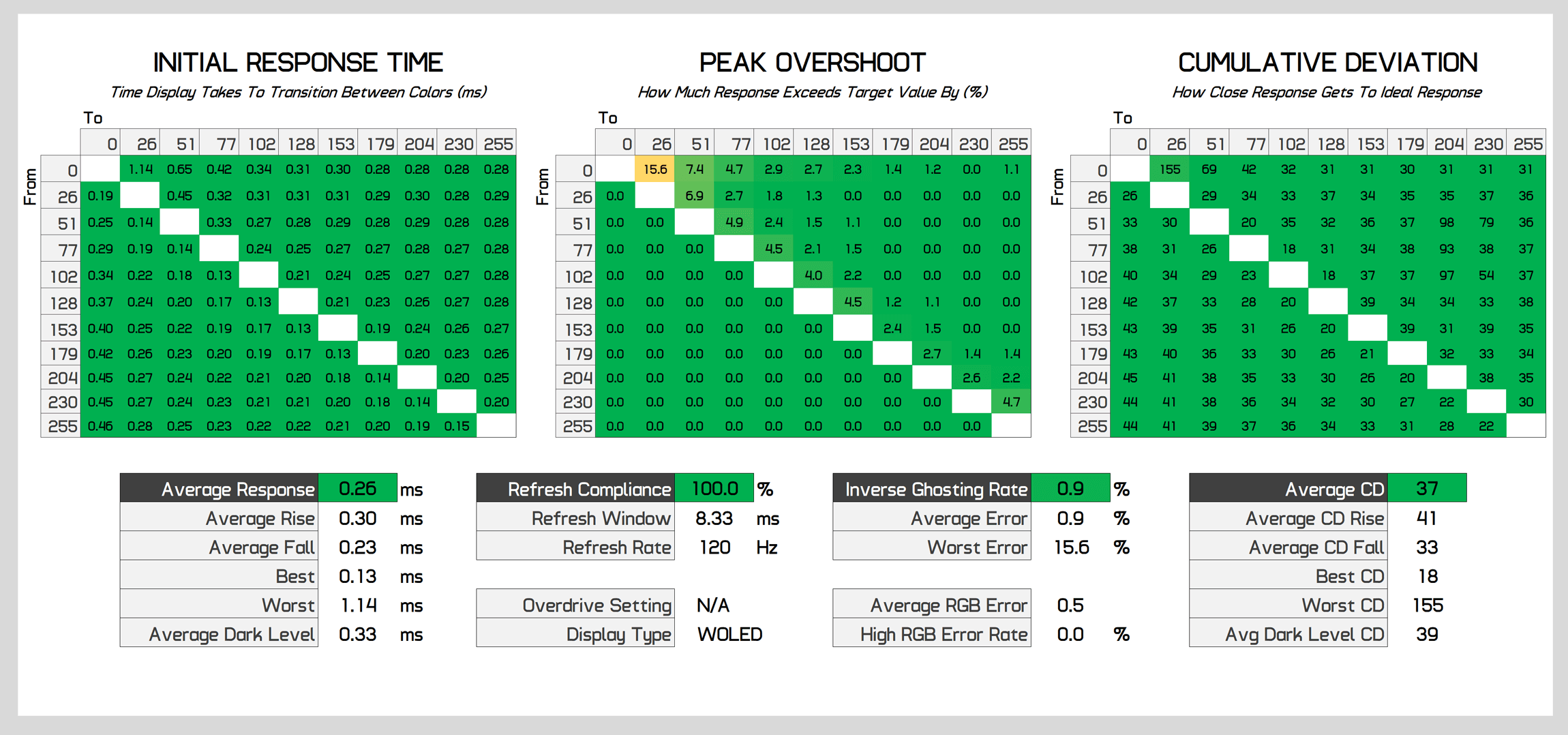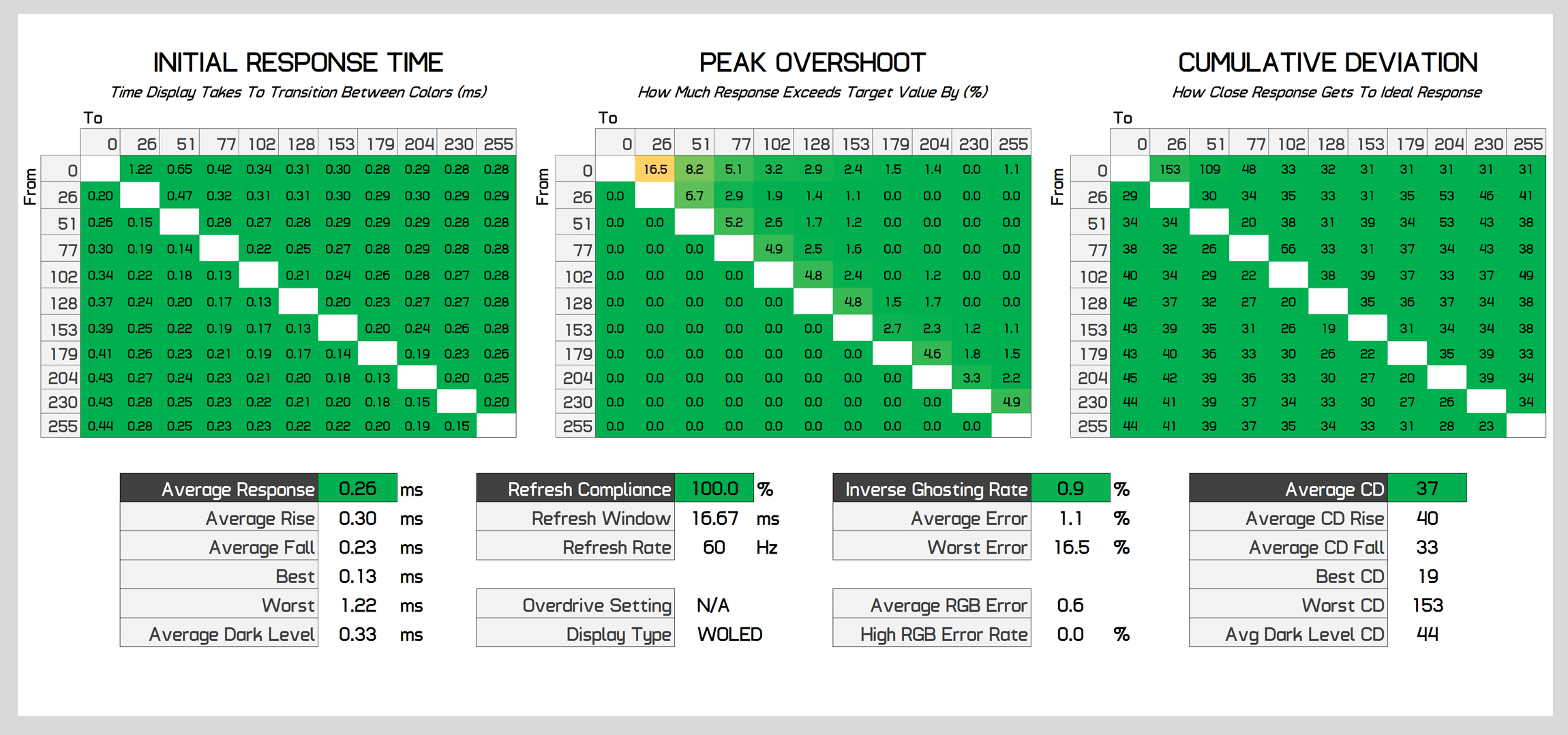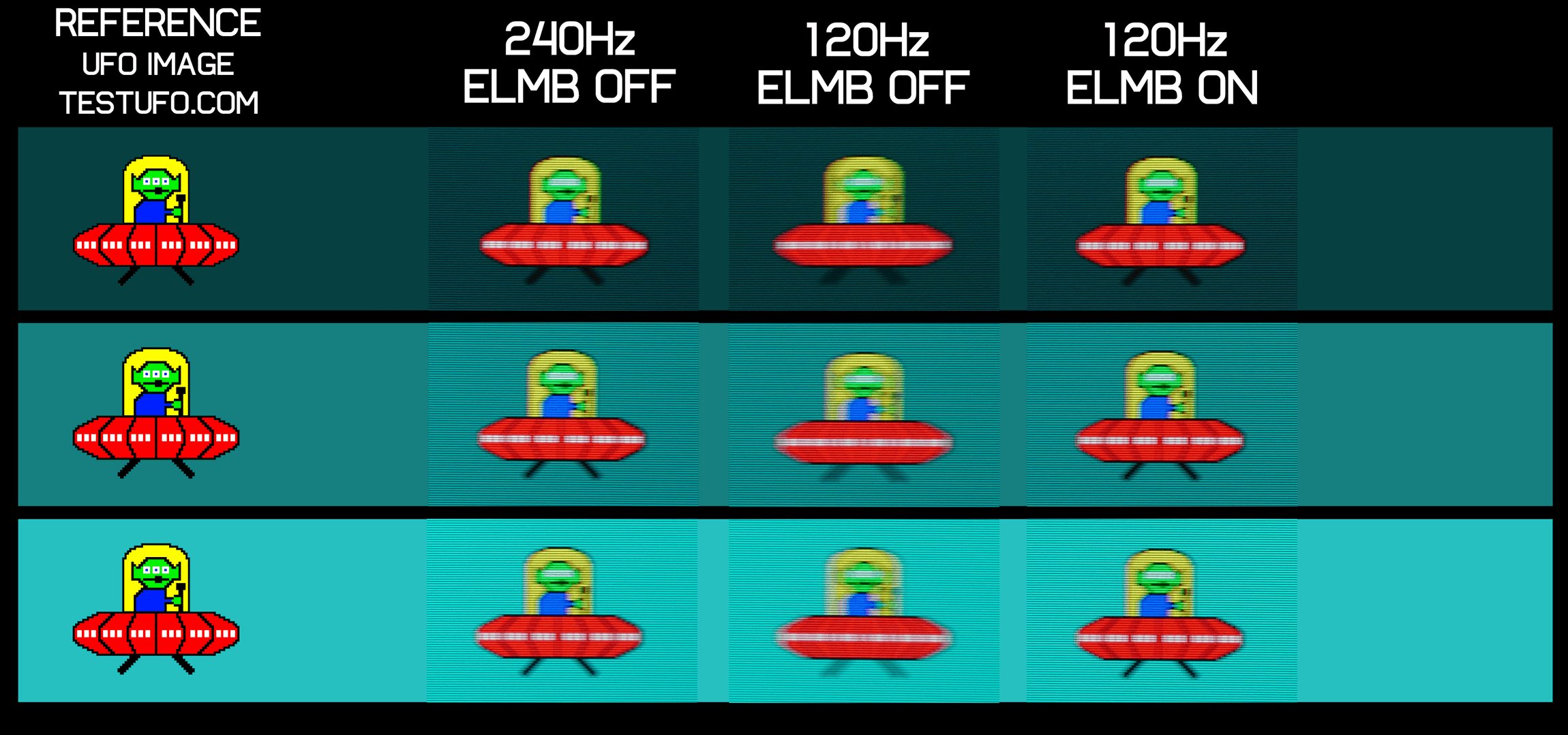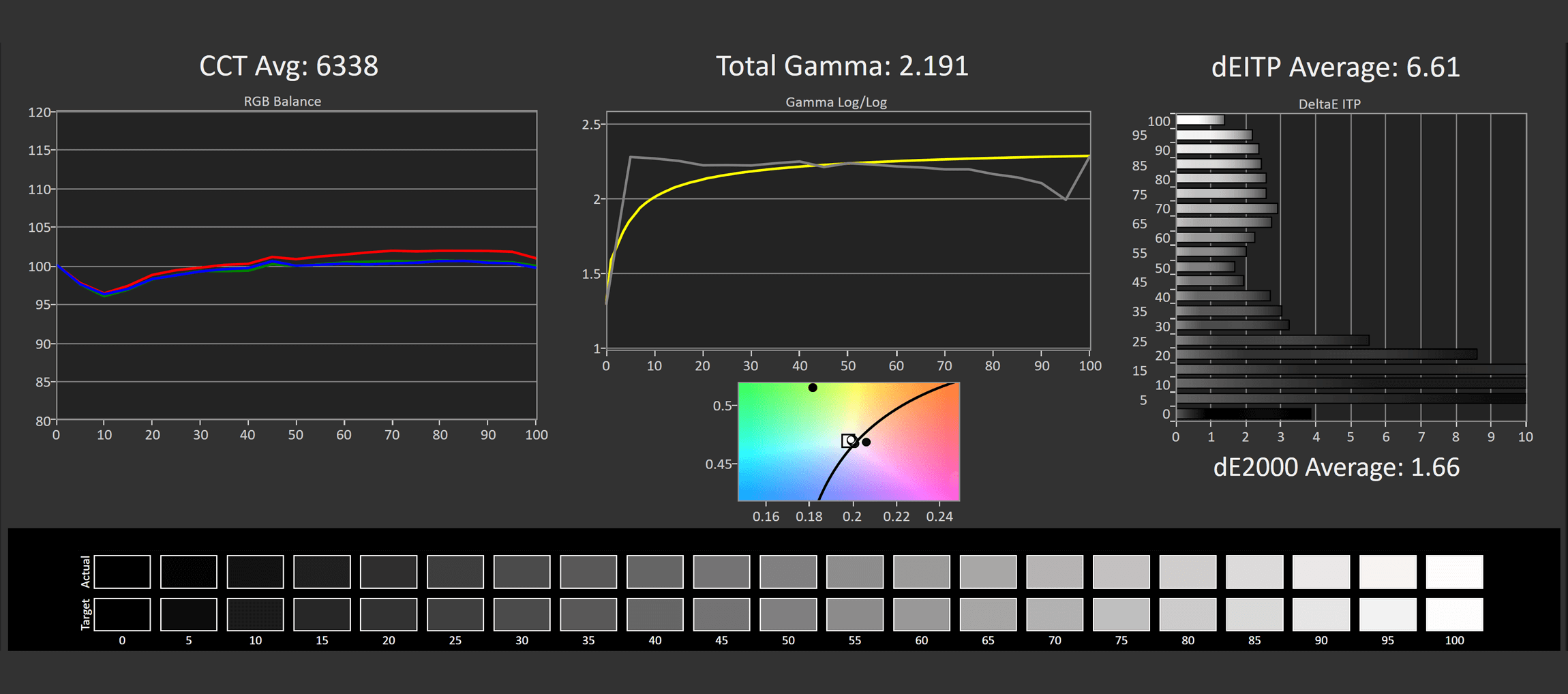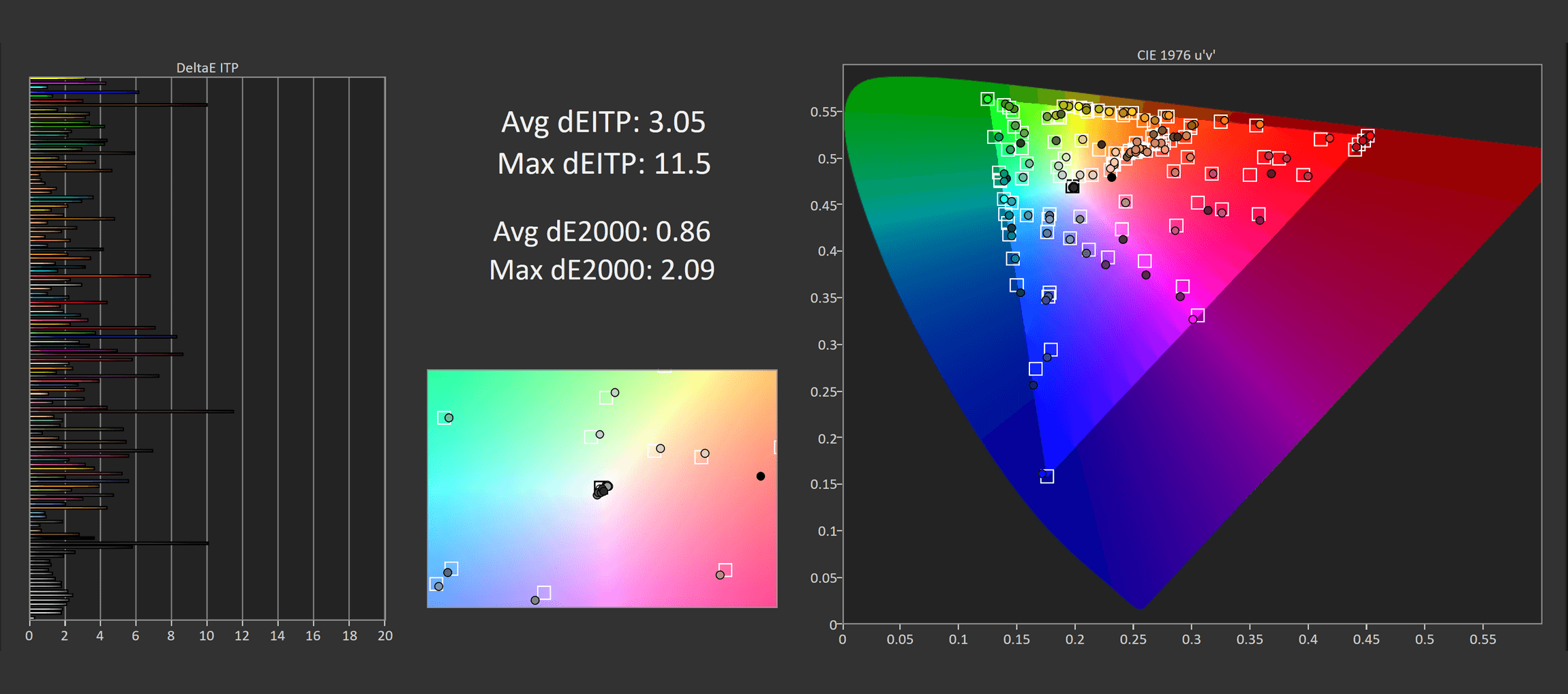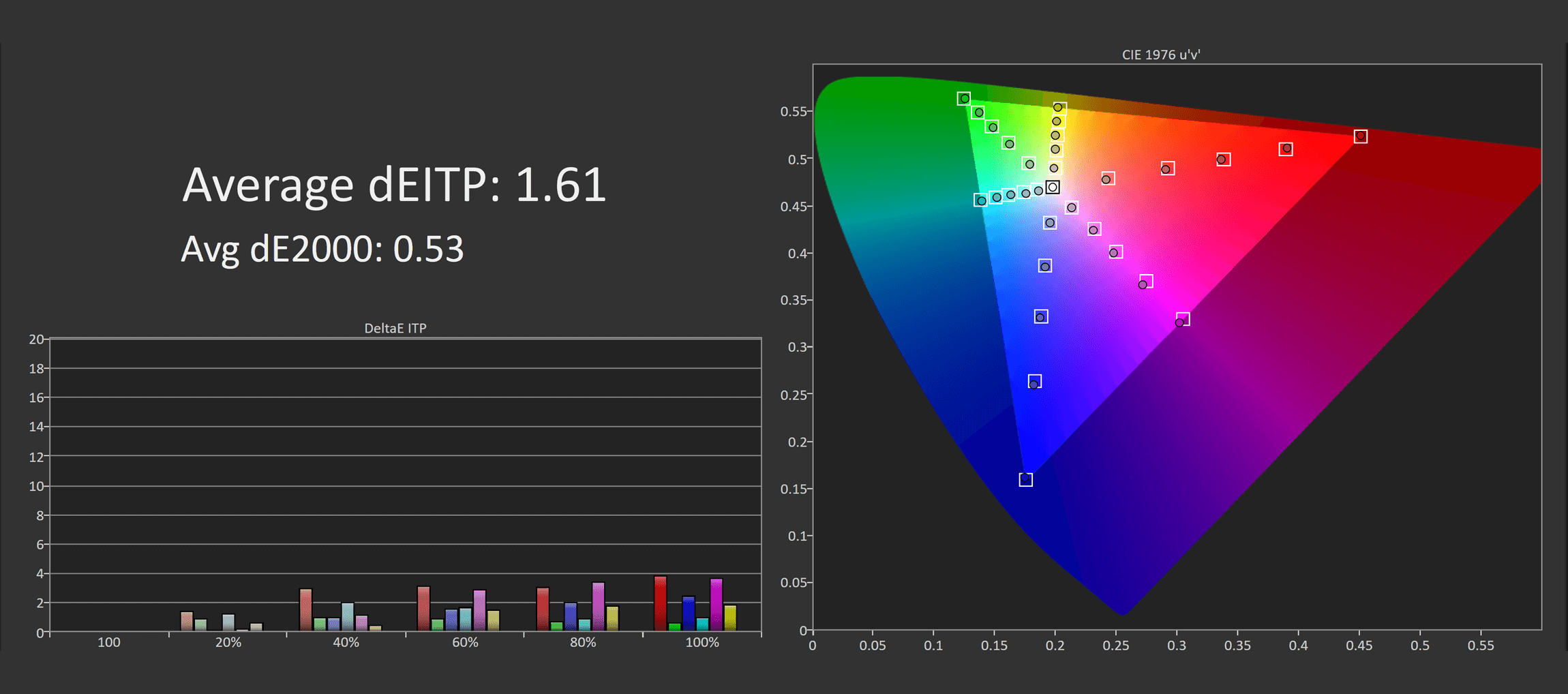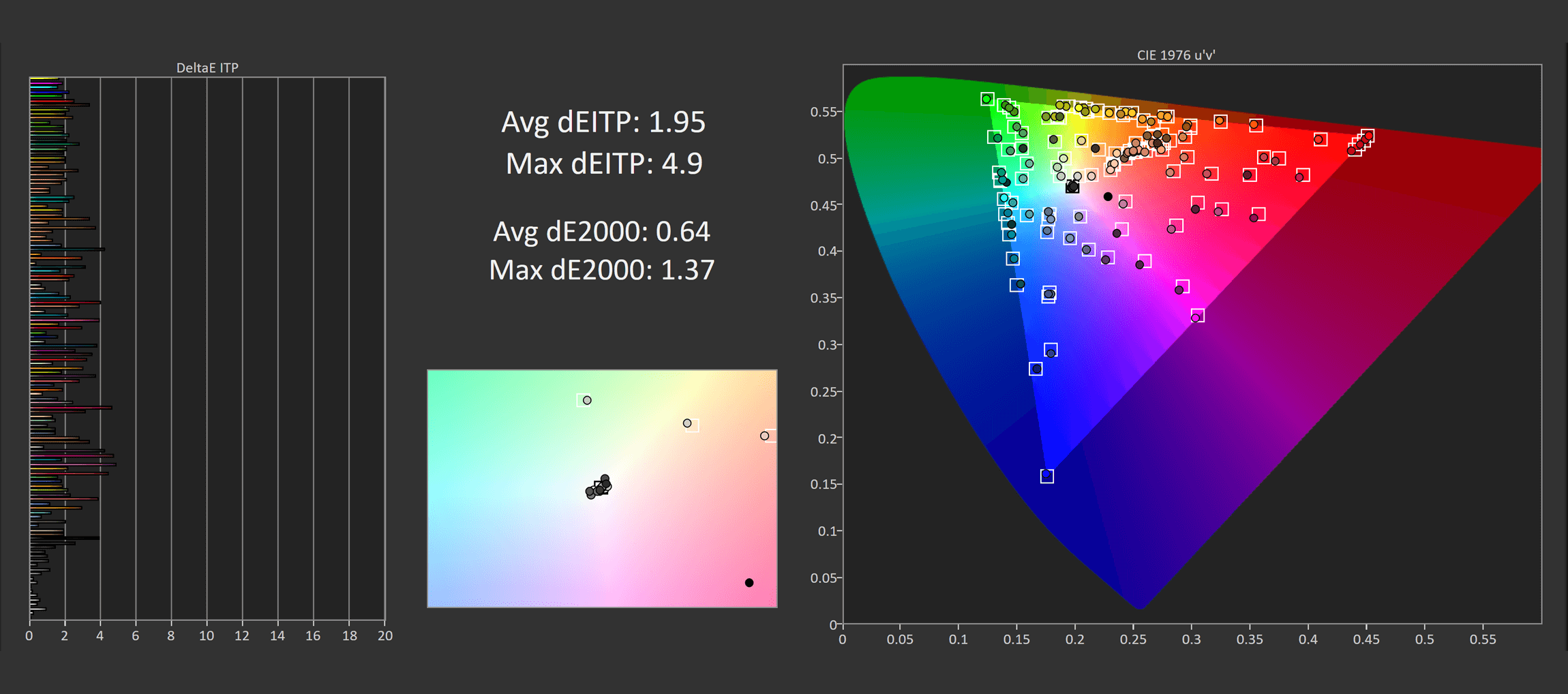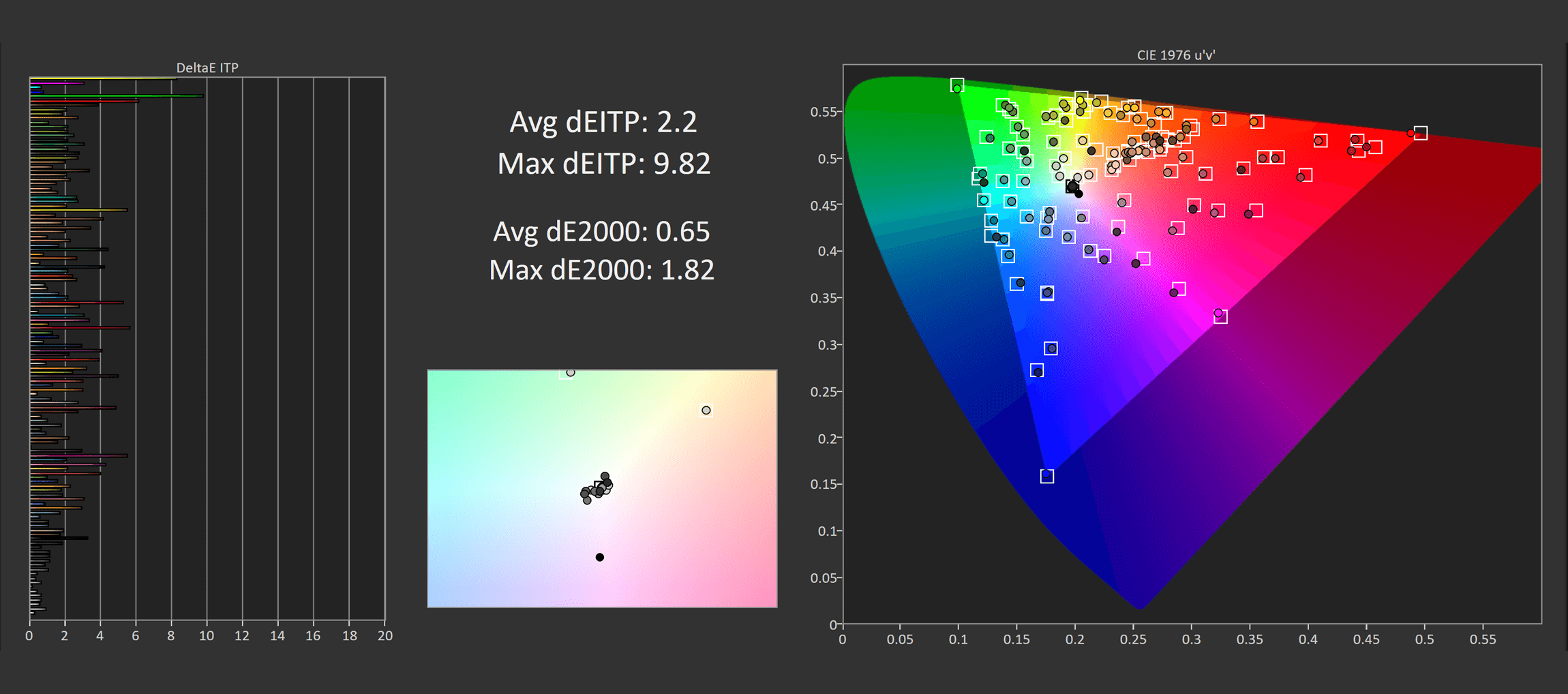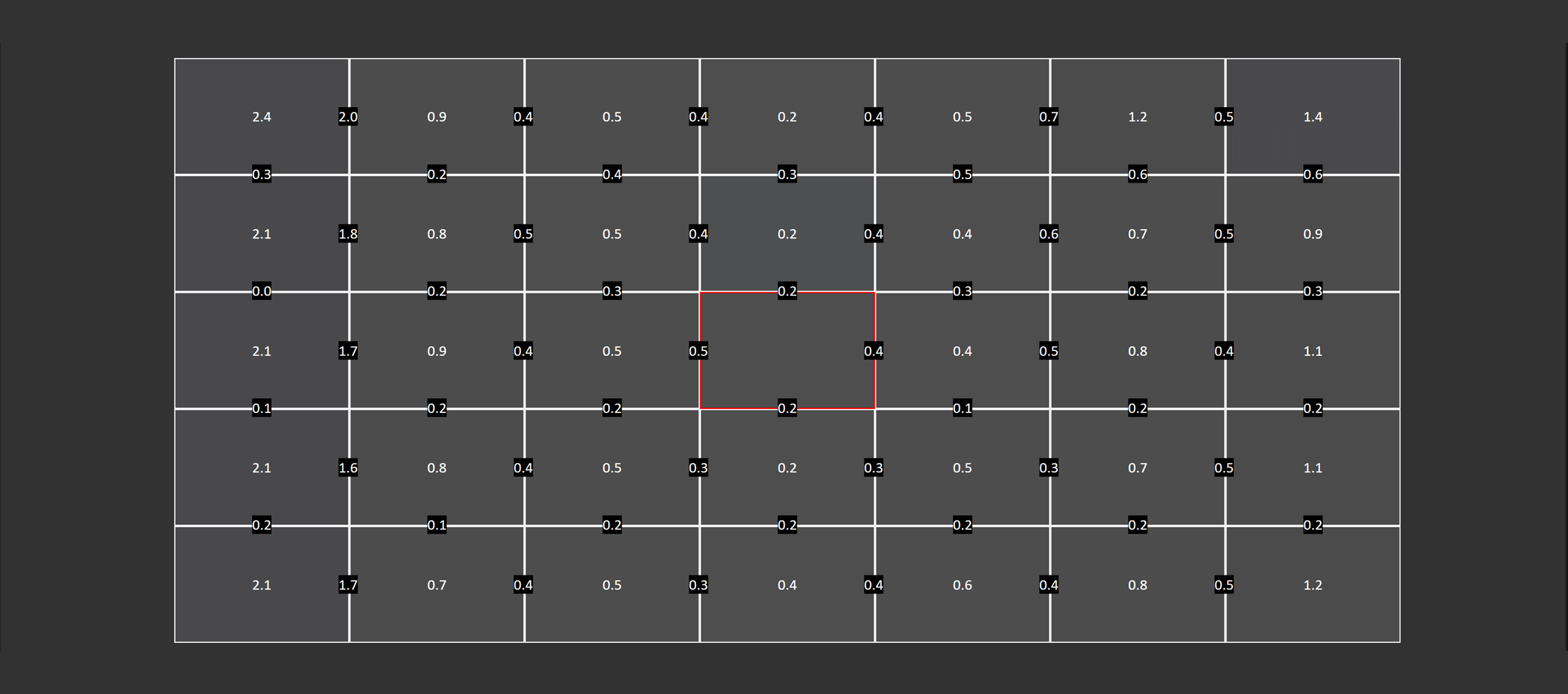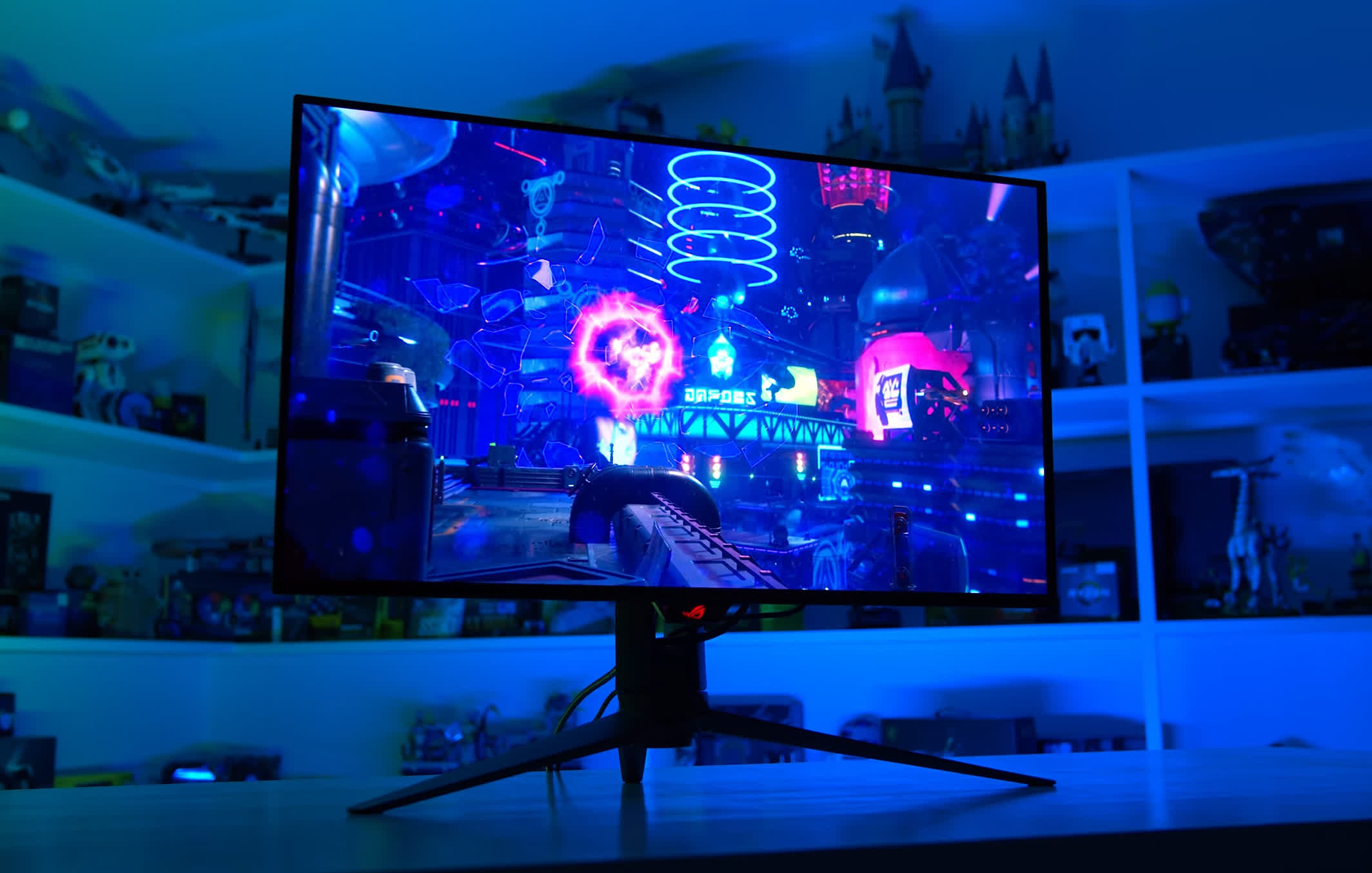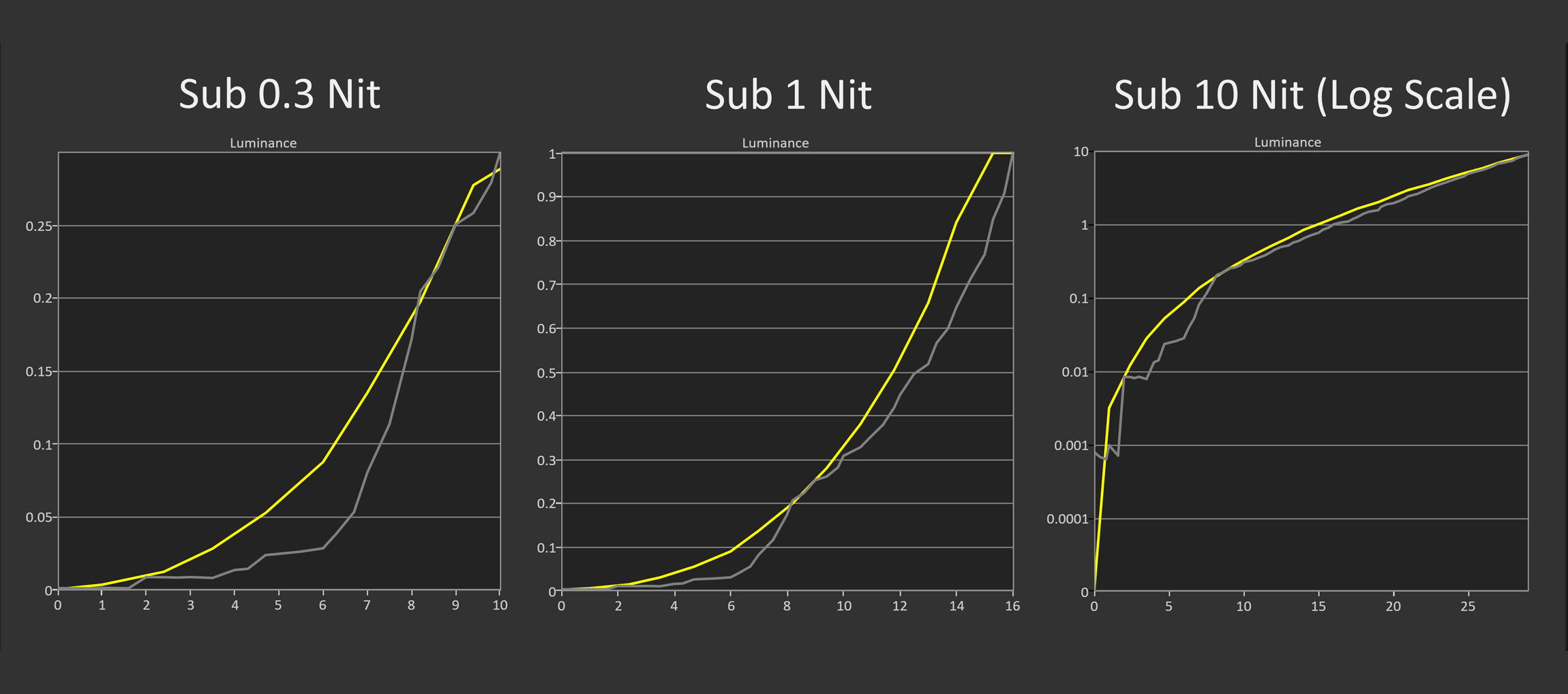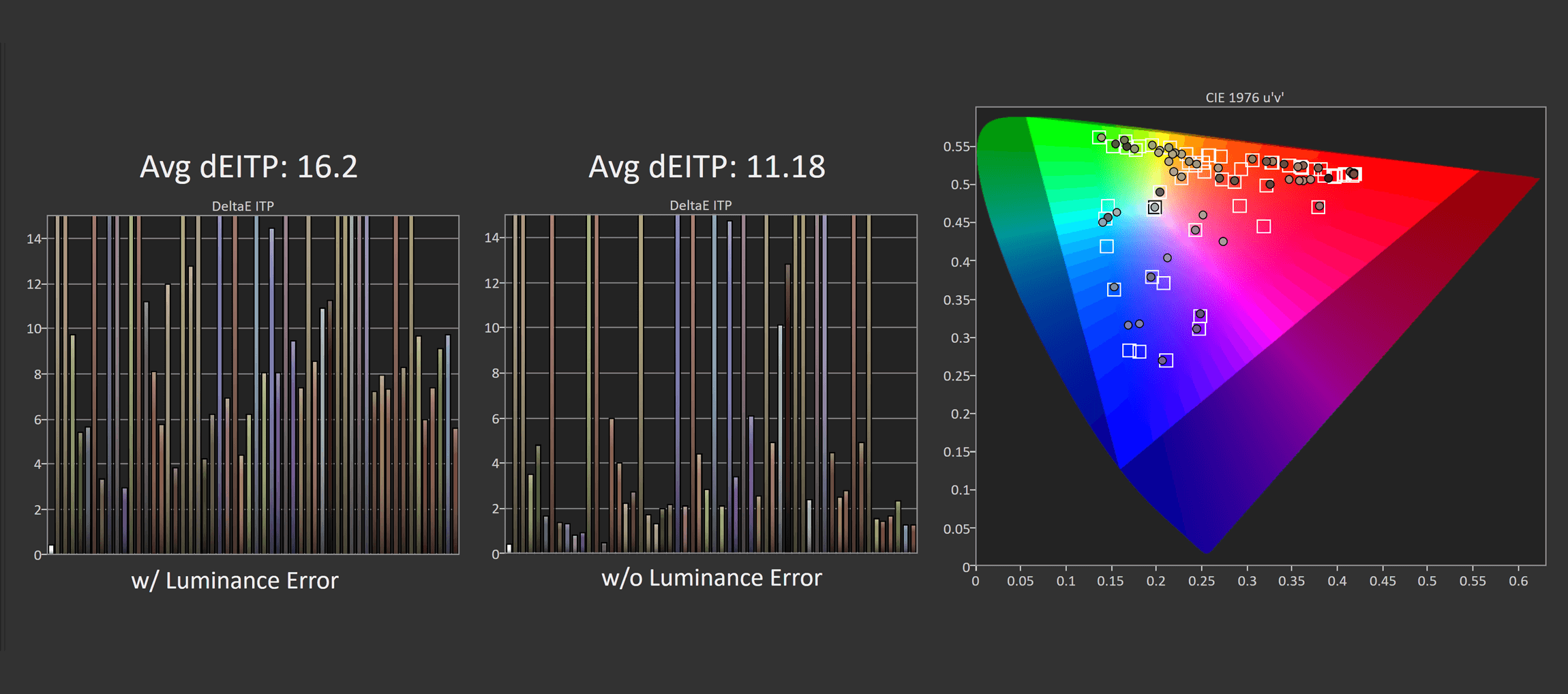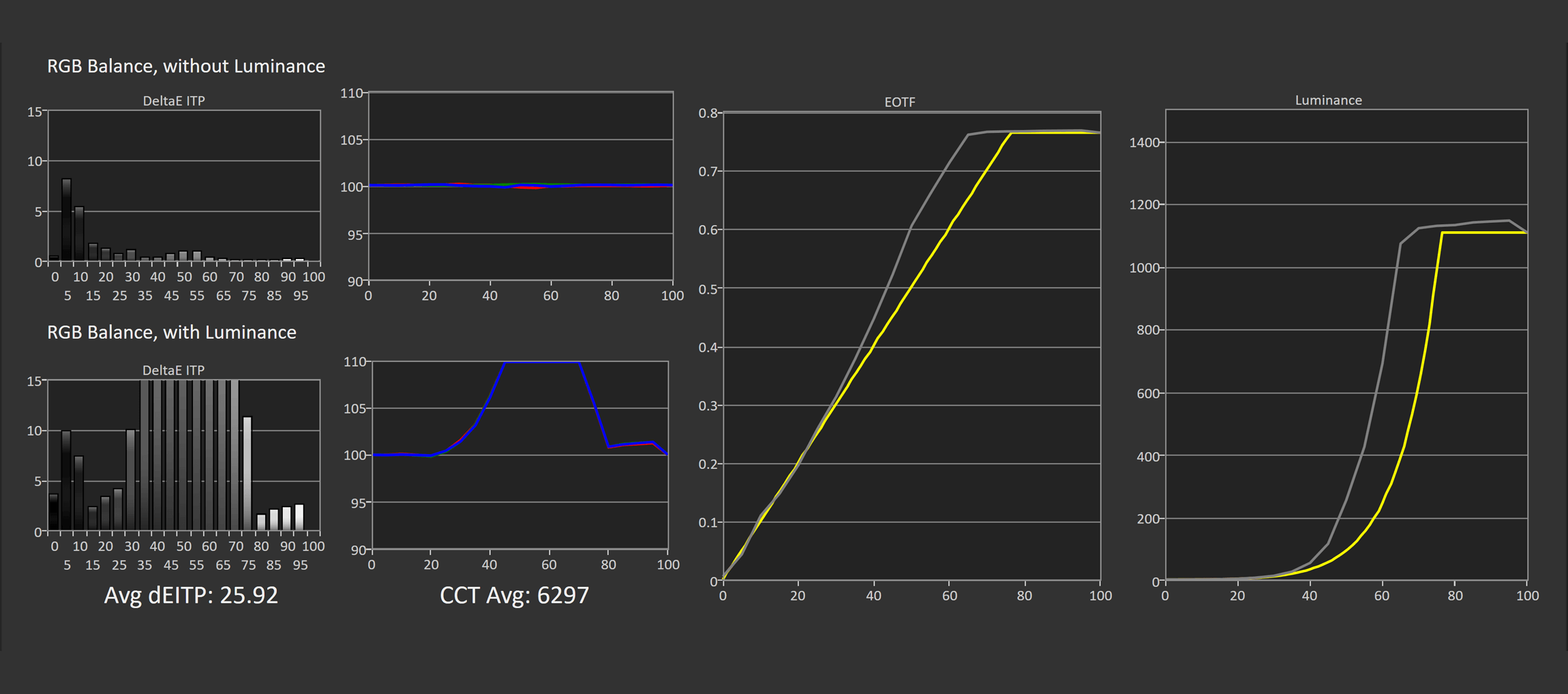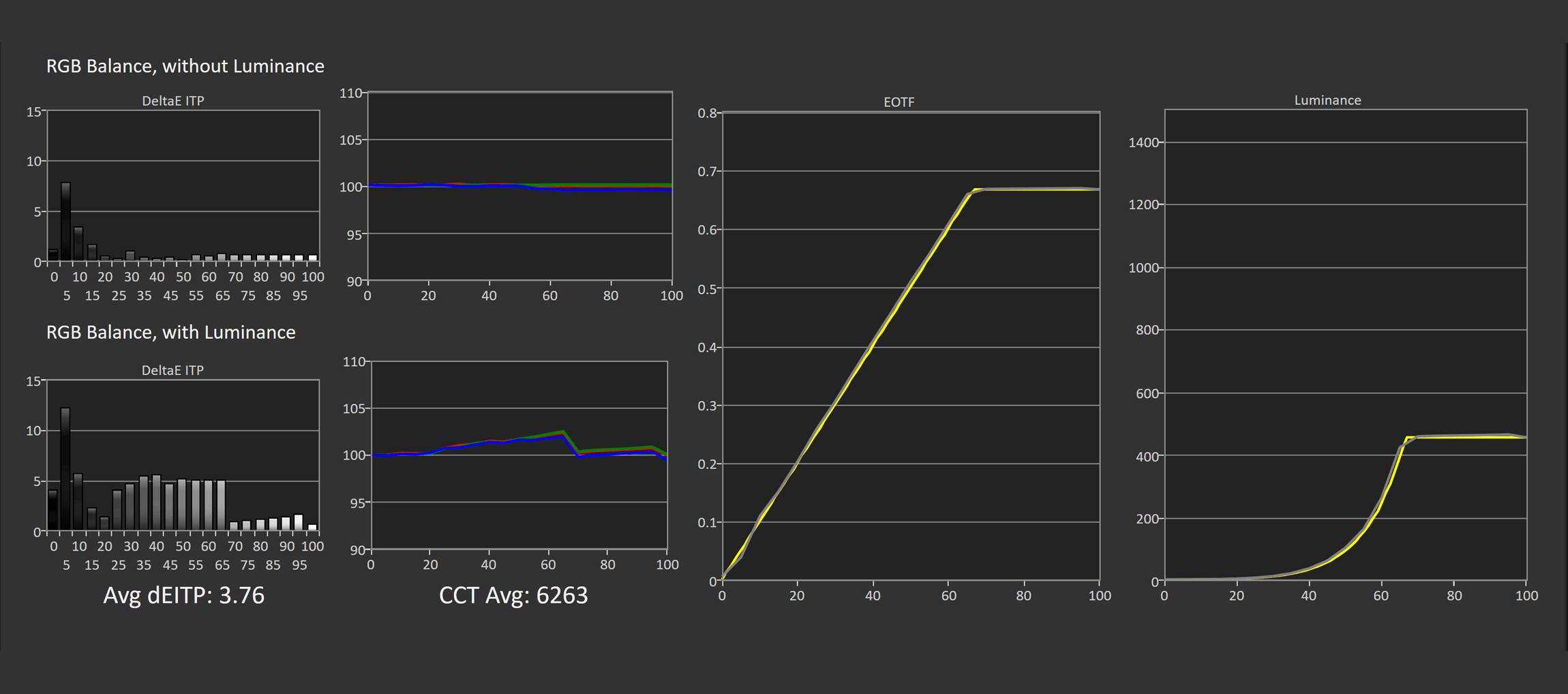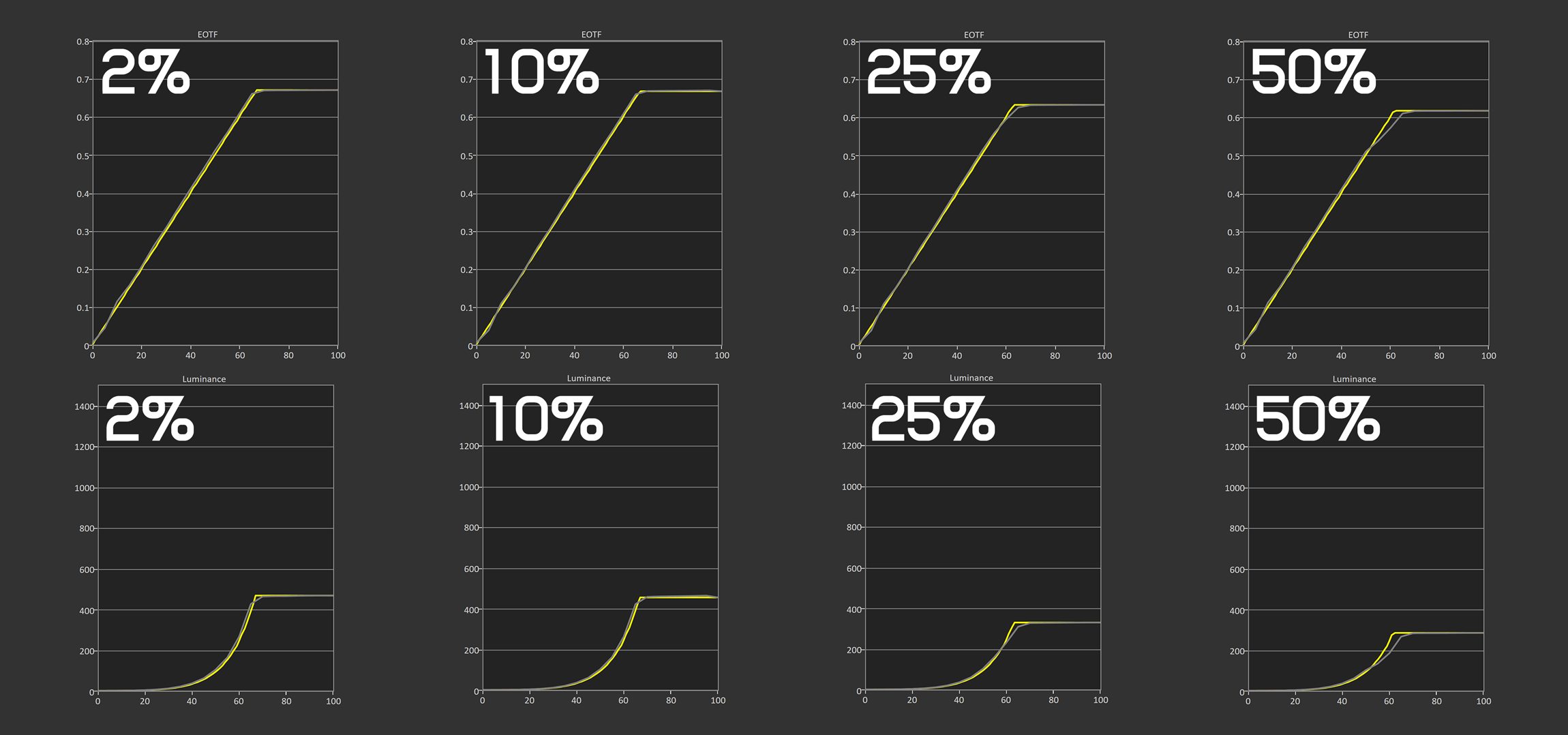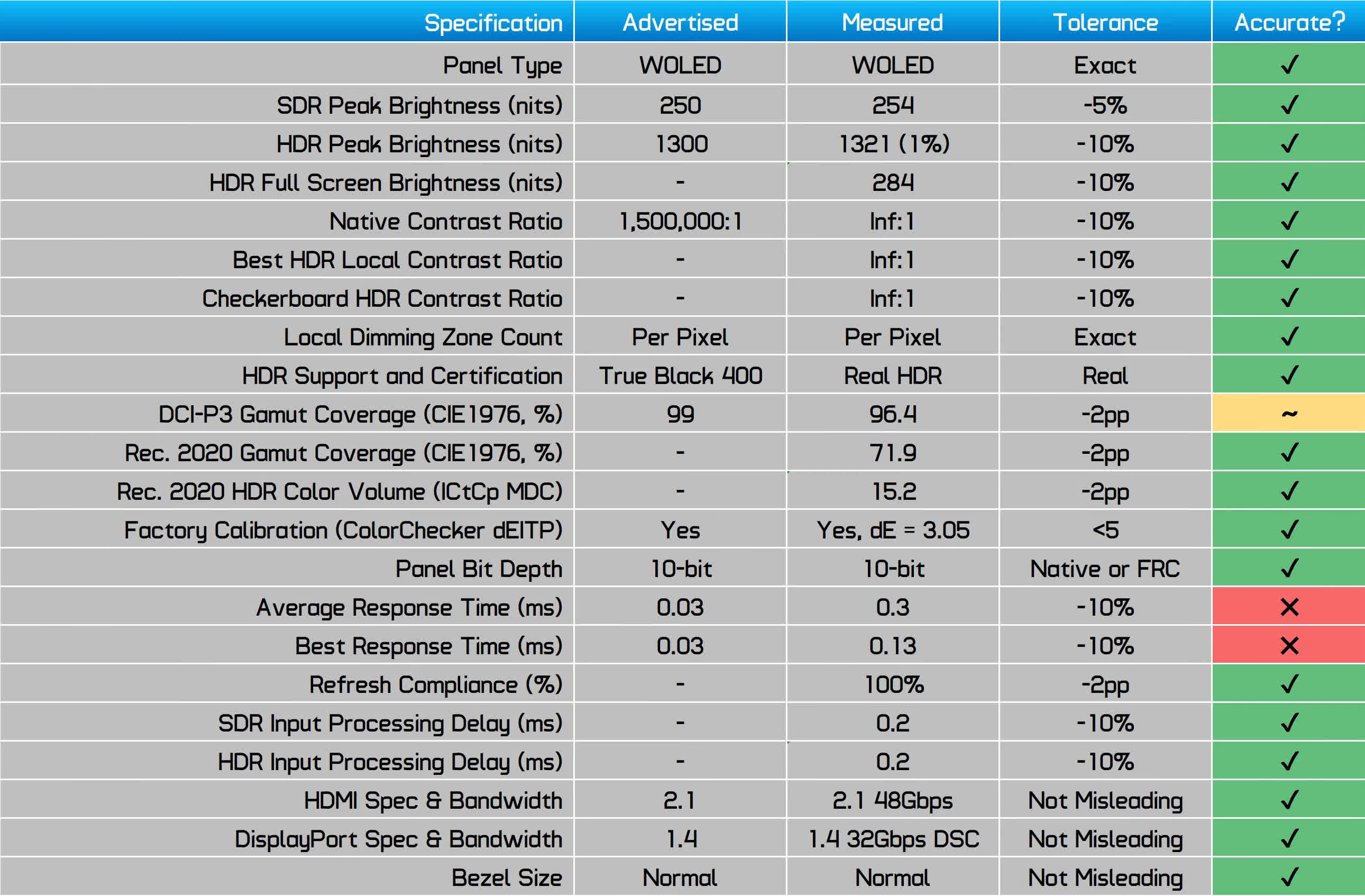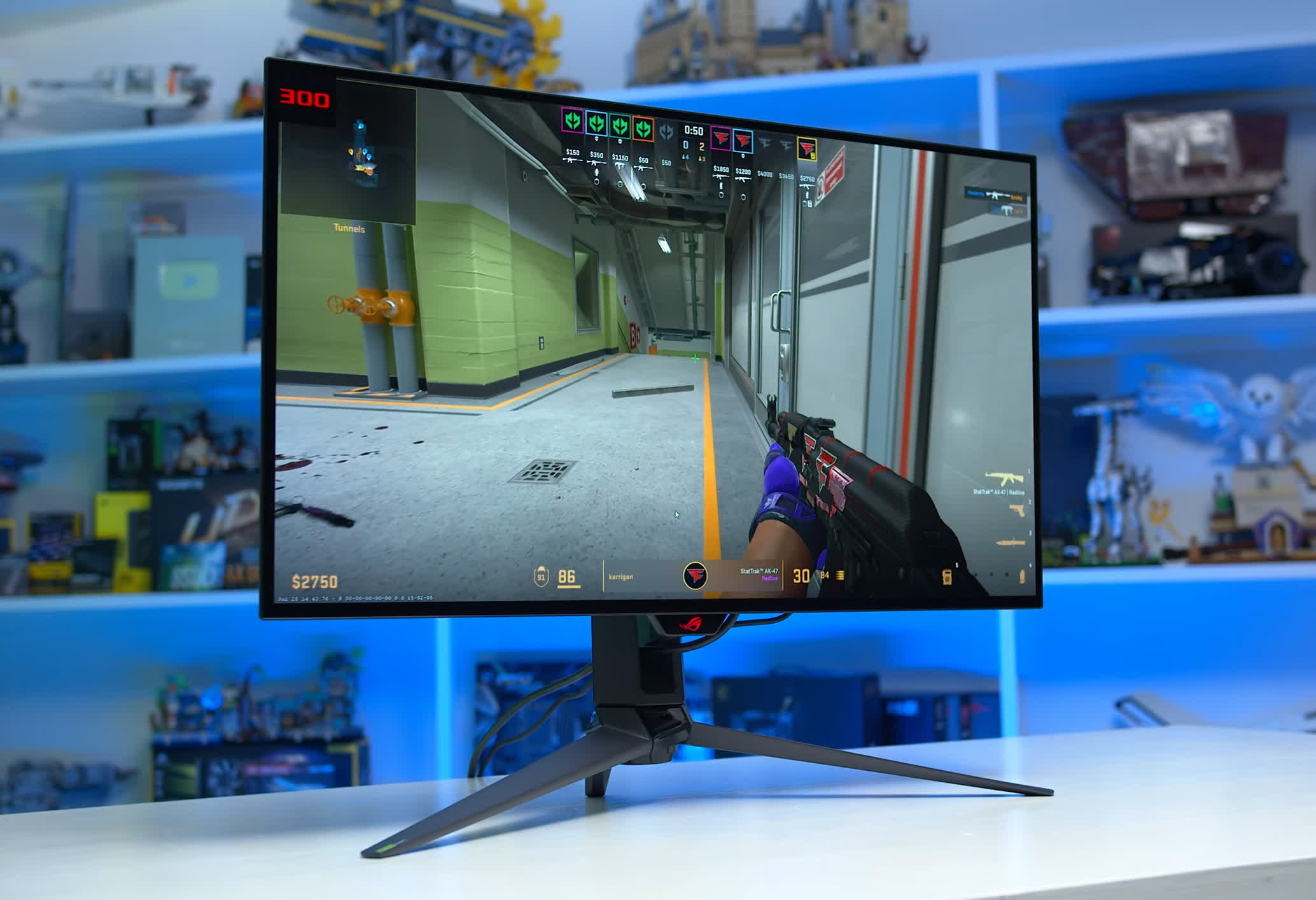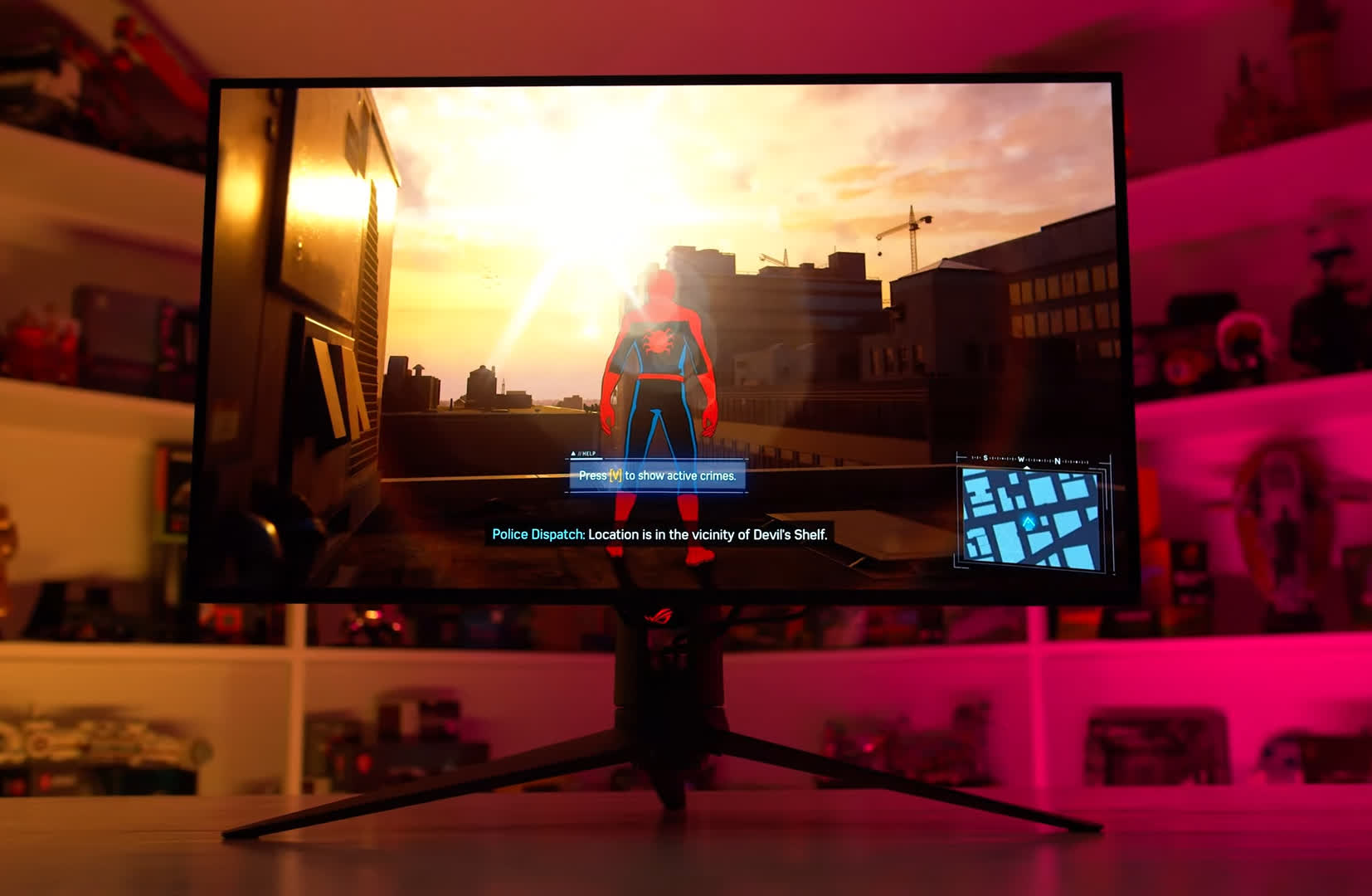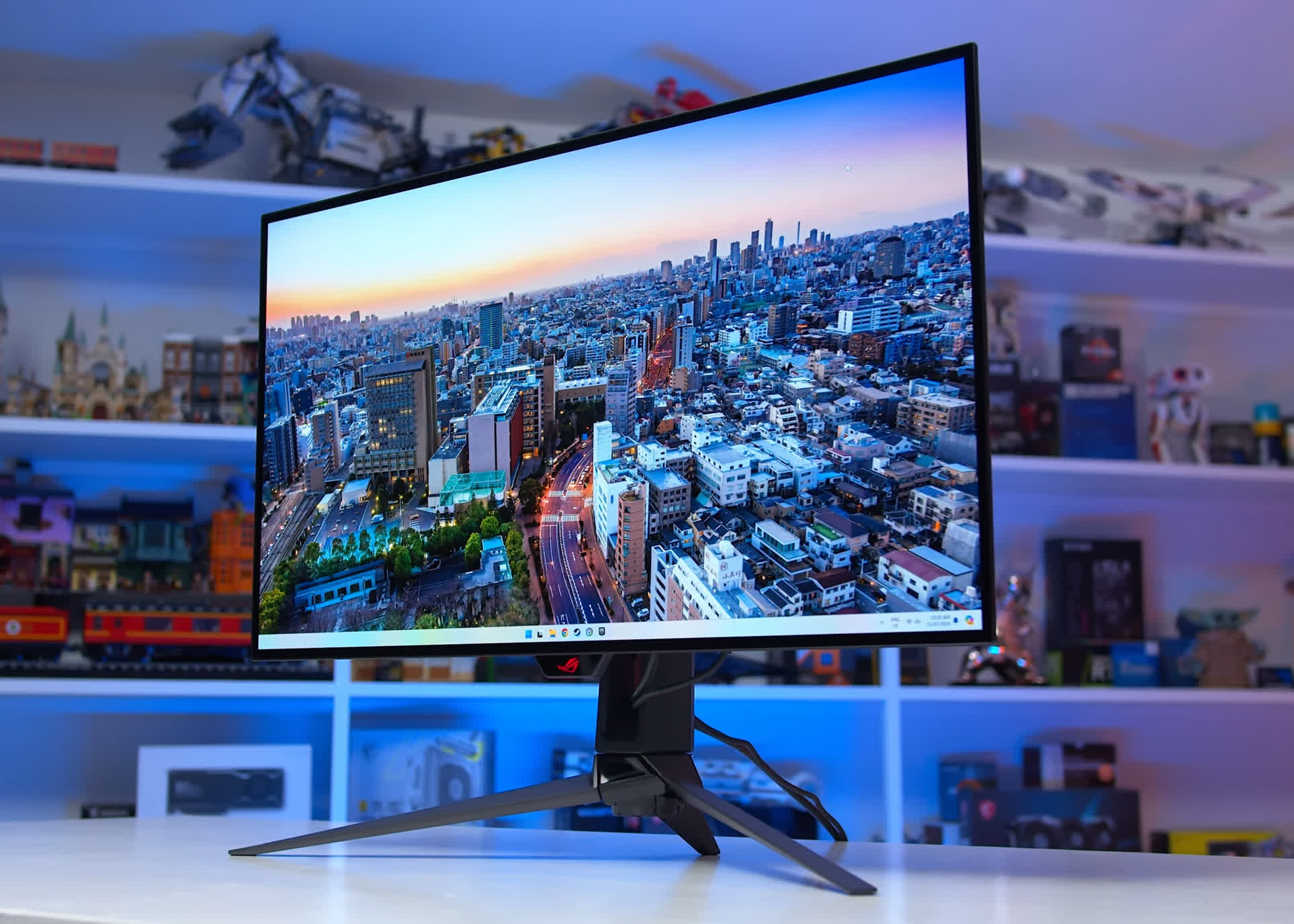Recently we checked out the LG 32GS95UE, an interesting 32-inch WOLED gaming monitor with dual mode functionality, meaning it can operate at either 4K 240Hz or 1080p 480Hz. Today, we're checking out the Asus ROG Swift OLED PG32UCDP, which uses the same LG panel but incorporates Asus' feature set and tuning.
Now, you might be thinking, "Didn't Asus already release a 32-inch 4K OLED gaming monitor earlier this year?" You'd be correct; they did. It was the ROG PG32UCDM which we also reviewed and uses a different Samsung QD-OLED panel, offering a different set of features including a glossy display and Dolby Vision support, but no 1080p 480Hz mode.
The Asus PG32UCDP is a WOLED alternative with similar specifications. To keep things simple, UCDM is the QD-OLED model, and UCDP is the WOLED model, both featuring a baseline 32-inch 4K 240Hz spec. What will be more complicated will be choosing between these two as Asus has priced both at $1,300.
Features and Design
The PG32UCDP WOLED closely resembles the PG32UCDM, with Asus reusing their 32-inch OLED design. The front is dominated by the large WOLED panel with slim bezels on all four sides, along with an ROG logo below the display.
The OSD controls are located behind this logo. The back features the usual central box design housing all the main display components, with the thin OLED panel extending outward.
Asus maintains a distinct "gamer" aesthetic with a large RGB LED logo on the rear panel, various plastic finishes, and numerous angular elements. There's even a projected ROG logo at the bottom of the stand pillar.
Speaking of the stand, it's a standard ROG design with three elevated metal legs and a strong pillar that supports height, swivel, and tilt adjustments. The build quality of the unit wasn't amazing; there was a noticeable creaking sound when tilting the display – something smoother is expected at a price over $1,000.
For ports, Asus has included a good range of connectivity options, including one DisplayPort 1.4 with DSC, two HDMI 2.1 48 Gbps ports with DSC, and a USB-C port with DP Alt mode and 90W of power delivery. There's a three-port USB 3.2 hub and a built-in KVM switch, which the LG model lacks. All ports support full 4K 240Hz, but DSC must be used for both HDMI and DisplayPort, which we believe is a non-issue. DSC can be disabled in the OSD for compatibility reasons, at the cost of refresh rate.
The PG32UCDP's OSD feature set includes many familiar options from Asus, such as multiple color modes, unlocked color space emulation, several OLED care features, and numerous gaming features like crosshairs, shadow boosting, and a sniper mode.
Asus has also added some questionable "AI Assistant" features, likely to capitalize on the AI hype train. For instance, the "AI crosshair" is just a normal crosshair – usually blue or green – that changes color based on the background. So if the background is dark, the crosshair turns white, if the background is orange the crosshair turns pink. It's a potentially useful feature but let's be honest, implementing it does not require any AI model whatsoever, so calling that an "AI crosshair" is dumb.
Additionally, Asus has included an "AI Moba Map Helper," which supposedly "analyzes the on-screen mini-map and highlights the location of enemies." To us, this sounds like cheating. However, when this feature is enabled, a "practice mode" message appears in the corner of the monitor, ostensibly to prevent its use in competitive play.
Do we really need to stoop to the level of integrating hardware cheats into monitors that are scanning the screen and highlighting enemies or other important information?
Screen Coating, Subpixel Layout and Burn In
Regarding text clarity, the UCDP uses the same 4K WOLED panel as the LG 32GS95UE, featuring the same RGWB subpixel layout and 140 PPI pixel density. This results in a significant improvement in text quality compared to previous WOLED panels.
The newer, higher-density design is very suitable for text-heavy productivity work, with few artifacts even at 100% scaling.
We have a full feature exploring the differences between 4K WOLED and QD-OLED panels. In short, we still believe QD-OLED panels have a slight edge in text clarity, though the artifacts differ – color fringing on QD-OLED and shadowing on WOLED.
While LCD remains superior in this aspect, the differences between the two OLED variants aren't significant enough to be a major deciding factor when choosing a monitor. To the disappointment of some, the UCDP uses the same matte coating as most other WOLED monitors, providing a contrast to glossy QD-OLED.
The main advantage of the matte coating and WOLED screen composition is their performance in brighter environments. WOLED preserves deeper blacks in bright rooms by reflecting less ambient light. The matte screen coating also prevents mirror reflections, instead diffusing light, making it less likely for reflections to distract you.
The disadvantage is the coating grain, which, while mild to moderate, reduces the apparent sharpness of the panel. In some environments, the matte coating's light diffusion can also result in a lower apparent contrast ratio. In a light-optimized setup, glossy QD-OLED typically looks clearer with more 'pop' to the image.
Whether matte or glossy is better for you is highly subjective and depends largely on how you use your monitor and the environment it will be in. It's great that multiple options are available – if you prefer glossy, opt for a QD-OLED, but if a matte finish suits your needs for bright room usage, this 4K WOLED is a good choice.
As with all OLEDs, there is a risk of permanent burn-in when using this display for prolonged periods with static content, such as many desktop or productivity apps. This makes it challenging to recommend for those who primarily use their monitor for work, with only occasional gaming or content consumption. However, for those who mainly use their monitor for entertainment, this should not be an issue.
Asus offers a better burn-in warranty than LG with their WOLED variant. The Asus website clearly specifies a three-year warranty that includes panel burn-in. In contrast, LG offers only a two-year warranty, with no specific mention of burn-in coverage. Although LG claims to cover burn-in, this has only been communicated via email rather than clearly stated on their website.
Response Time Performance
In its main 4K 240Hz mode, response time performance is excellent, as it is for other OLED displays we've tested so far. OLED offers lightning-fast response times, around the 0.3ms mark at its maximum 240Hz refresh rate, which leads to fantastic motion clarity.
OLEDs also maintain the same performance at all refresh rates, so even when testing at 120Hz or 60Hz, we see similar results in the 0.3ms range. This is a nice benefit for variable refresh rate gamers, resulting in a single overdrive mode experience; in contrast, many LCDs typically perform worse at lower refresh rates relative to their maximum refresh.
The major limiting factor to OLED motion performance right now is the refresh rate itself. As a sample and hold monitor, OLEDs still have some blur in fast motion scenes, and the level of blur depends on the refresh rate.
At 4K 240Hz, clarity is superb, but when running the display closer to 60Hz, clarity is reduced simply because the refresh rate is reduced, even though response time performance is basically identical at 240Hz and 60Hz. Still, having such fast response times gives OLED a noticeable advantage over a slower response time LCD running at the same refresh rate.
There is effectively no difference in response time performance between this WOLED and other OLED monitors, including QD-OLED variants. This means motion clarity is identical when the refresh rate is the same. However, OLEDs are much faster than even the fastest LCDs we've tested, and this is true whether we look at the best performance or average performance across the refresh rate range. Not only are OLEDs fast, but they also have no overshoot artifacts, which can be an issue with some LCD models.
When viewing cumulative deviation results, we can see that OLEDs get much closer to ideal response time behavior, and in most cases, offer performance an order of magnitude better in this metric than LCDs. In practice, this leads to around a 1.5x advantage in clarity at a given refresh rate, so 240Hz OLEDs like the UCDP offer a similar experience to 360Hz LCDs. The only displays with clearly superior clarity are LCDs that offer elite backlight strobing, a feature that comes with its own set of limitations, like incompatibility with variable refresh rates.
Dual Mode: 1080p 480Hz
Like the LG 32GS95UE and unique to WOLED variants, the UDCP also offers a 1080p 480Hz configuration, which is accessible through a toggle called "Frame Rate Boost." When switching into this mode, the only thing that changes is the refresh rate and resolution; it otherwise performs exactly the same as the 4K mode. So the same response times, input processing lag, HDR support, and color performance.
Obviously, the 1080p 480Hz configuration is designed exclusively for fast-paced gaming. Text clarity and sharpness in this mode are pretty bad, but it's not overly noticeable when playing games like CS2 or Apex Legends. Provided you have a fast PC, you're more likely to benefit from the higher refresh rate, better motion clarity, and lower overall input lag than a higher resolution in those types of games.
The only real difference between the 480Hz mode on the Asus model and the LG model is the size emulation modes. Both variants offer settings that emulate the size of a 27-inch or 24-inch monitor, but only the LG model allows you to do so with variable refresh rates enabled. On the Asus model, you have to disable adaptive sync to access the feature, which makes it less useful, though we're not sure how many people would actually use this configuration. Some competitive gamers have told us they prefer smaller 24-inch screens as it makes it easier to have every enemy in your field of view, so we'll take their word for it. Asus also offers a "pixel by pixel" mode which offers what should be 1:1 pixel mapping and a 16-inch display area, but it looks atrocious and quite pixelated, so it doesn't seem to work properly.
What's of most interest with this mode is motion clarity. At 480Hz with no black frame insertion, this is a very clear monitor, a step better than what we've seen from 1440p 360Hz QD-OLEDs recently. Looking at the Blur Busters UFO Test, the text, for example, is the most readable it's ever been, even in comparison to the 540Hz TN LCD PG248QP. Given you get this clarity with full adaptive sync and HDR support, we'd say this is the most versatile and possibly the best high motion clarity mode we've tested yet. With OLED typically offering around a 1.5x clarity boost compared to LCD at the same refresh rate, what we're seeing here should be equivalent to an LCD operating above 700Hz.
Don't worry, the 4K 240Hz configuration also delivers excellent motion clarity, though it's basically the same as we've seen from other 240Hz OLEDs. We think the majority of gamers using this panel will stick to the 4K 240Hz mode most of the time, but if you need the extra clarity, the 480Hz mode is a great choice.
The only legitimate challenger to a 480Hz OLED in motion clarity at the moment would be a 540Hz LCD with backlight strobing enabled, such as the PG248QP. It's actually a lot closer than we thought it would be, but in edge case scenarios, especially super fast motion, a strobed LCD does deliver superior clarity. With that said, backlight strobing on something like the PG248QP is highly restrictive; you have to sacrifice variable refresh rates and HDR, run your game at a locked frame rate that matches the refresh rate for it to work properly, and typically, we only see this performance from TN LCDs, which have other issues like viewing angles. The PG32UCDP gives you great motion clarity in a much broader range of conditions, so this 1080p 480Hz mode is a big winner in our opinion.
Exclusive Asus Features: ELMB and Anti-Flicker
Asus offers two additional features that separate this display from the pack. One is ELMB black frame insertion, which the LG model doesn't support. This feature works to boost the clarity of 120Hz gaming up to the level of 240Hz by displaying every second frame as a black frame. It achieves this by technically running at 240Hz for a 120Hz signal input. Interestingly, you can only use ELMB at 120Hz in both the 4K and 1080p "dual mode" configurations – there's no support for ELMB at 1080p 240Hz, which would have effectively run the monitor at 480Hz. You also have to sacrifice VRR, HDR, and some brightness.
At 120Hz, using ELMB does look clearer than not using ELMB, but the implementation is far from perfect. As this is simply showing a black frame every second frame, the non-black image frames have a long strobe length – the length of each refresh cycle – which does lead to some blur relative to a well-strobed LCD that typically would produce a much shorter, sharper pulse. A short image pulse with a long black cycle produces the best image clarity, but this OLED really isn't capable of doing this; all it's doing is running its normal refresh cycle and switching between an image frame and a black frame. The end result is that the ELMB mode at 120Hz looks similar, maybe a little clearer than 240Hz without BFI, while being much more restrictive. It's a nice bonus feature, but we personally wouldn't use it, and it's not able to deliver the crystal-clear output of the best backlight-strobed LCDs like the Asus PG248QP.
The second feature is OLED Anti-Flicker, designed to combat variable refresh rate flicker in rare scenarios. Like we saw in the Asus XG27AQDMG, all this feature does is nerf the VRR range. With the setting off, the monitor uses a 48 to 240 Hz range with low frame rate compensation, giving us an effective VRR range of 0 to 240 Hz. With Anti-Flicker on middle, the VRR range shrinks to 80 to 240Hz, and on high, it shrinks further to just 160 to 240Hz. In the 1080p mode, the ranges are 200 to 480 Hz on middle, and 250 to 480 Hz on high.
The good news here is that this is a less aggressive nerf than we saw with the initial XG27AQDMG implementation. The middle mode retains LFC support and an effective 0 to 240 or 480Hz range, just with LFC activating more often. The high mode surprisingly also allows LFC, but deactivates between 120 and 160 FPS (when used at 4K) as it's unable to duplicate frames in that range, creating a jarring experience where the middle of the refresh rate range is susceptible to stutter or tearing but the upper and lower parts aren't. For that reason, we can't recommend using the high mode.
Anti-Flicker on middle, though, seems to work well and is a setting to consider using. Across extensive OLED gaming, we haven't encountered many instances of flickering during actual gameplay, but there's the occasional menu or loading screen where it occurs. In one of these examples in Cyberpunk 2077, enabling Anti-Flicker on middle reduced – but didn't fully eliminate – flickering. We think that's a win and will potentially help alleviate some of the worst instances of flickering in situations with extreme frame rate fluctuations.
Impressively, there is no difference in processing delay using the 4K 240Hz or 1080p 480Hz modes. We recorded a 0.2ms delay in both configurations, which is similar to the 32GS95UE and other 4K 240Hz OLEDs. As the 1080p 480Hz mode has a higher refresh rate, total input lag in that mode is lower as expected, providing a very responsive experience. You'll also see similar input latency in the HDR mode; no changes there.
Power consumption, as with most OLEDs, is on the high side when displaying 200 nits full white. WOLED gets an advantage here due to its dedicated white subpixel, so relative to a QD-OLED, power consumption in mostly white scenarios is around 35 to 40% lower. However, in other scenes where we don't see a white subpixel advantage – like a full screen Steam Store homepage – power consumption is still around 47 watts, whereas this dropped to 32 watts on the QD-OLED PG32UCDM. It really depends on the APL of the content and what colors are being shown; the difference can range anywhere from WOLED being much more efficient to QD-OLED being much more efficient.
SDR Color Performance
Color Space: Asus ROG Swift PG32UCDP - D65-P3
The color space on offer from this WOLED panel is identical to others we've seen over the last few years. The focus here is on DCI-P3 coverage, and we get 96% coverage with this monitor, which leads to 72% coverage of Rec. 2020. This is the same as other WOLEDs but not as good as QD-OLED, which offers a higher 79 to 80% coverage when we look at the recent crop of 4K models.
Default Color Performance
The UCDP has great factory calibration for the most part. In its default out-of-the-box configuration, greyscale performance is good, with an accurate color temperature and small issues with gamma. Like a lot of wide gamut gaming monitors, the color space is left unclamped for SDR use, leading to oversaturation in content like YouTube videos.
Out of the box, the UDCP is slightly less accurate than the UCDM in greyscale, with the LG variant sitting between the two models. While this is a pretty good result overall, the latest crop of 4K OLEDs have all come with above-average calibration, so it's tougher to stand out from the pack. In ColorChecker, it's much of a muchness.
sRGB Mode Color Performance
Where Asus has done well yet again is including a fully unlocked sRGB mode. The settings include a color space setting that can be switched to sRGB without blocking access to white balance controls, allowing users to fine-tune this mode. But even without fine-tuning, the included sRGB mode is excellent with low deltaEs indicating fantastic accuracy, superb clamping to the sRGB color gamut, and near-perfect white balance.
This puts the UCDP in a strong position competitively, though again, calibration is slightly behind the UCDM and the other QD-OLED competition. However, the results in greyscale are much better than the LG model, and the same can be said in ColorChecker. Asus has done a pretty good job of trying to calibrate this 4K OLED as well as their other offerings, so there's little difference between the two in this area.
Calibrated Color Performance
While you can calibrate this monitor further through tools like Calman, there isn't much point in doing so. When using the SDR mode, the sRGB configuration is excellent, and there's a wide range of hardware controls that can tidy up any small inaccuracies without the need for software profiles.
Brightness, Contrast, Uniformity
SDR brightness is no different from other OLED gaming monitors, with a maximum of 254 nits, slightly higher than the QD-OLED model and slightly behind the LG. This is a negligible difference and on the whole, still behind most typical LCD panels. Also, Asus offers a uniform brightness setting which is not enabled by default and caps the monitor to around this 254 nit level for all window sizes, rather than varying brightness as you resize windows, which is a behavior we find annoying. Minimum brightness is great at 31 nits.
Viewing angles from this WOLED panel are great, no concerns there whatsoever. Typically, what you are getting is better than what you'll see from an LCD. Uniformity was okay, a good result in general, though dark grey content is still not as uniform as you get from a QD-OLED. There's a bit of dirty screen effect here, not as much as you'll see from a 1440p WOLED, but still enough to be a noticeable downgrade compared to a QD-OLED side by side.
HDR Configurations and Accuracy
The Asus PG32UCDP is well suited to HDR from a hardware perspective. OLED panels, including WOLED, directly emit light and have individual pixel control, which makes them ideal for displaying HDR content. This feature allows each pixel to independently vary from fully switching off to displaying bright highlights, giving us deep zero-level blacks and per-pixel local dimming. The level of control OLEDs provide minimizes blooming in high contrast scenarios and allows for a clean distinction between bright and dark areas that are close together. Compared to LCDs with a multi-zone backlight, OLEDs have far fewer ugly illumination artifacts, which are most noticeable when displaying difficult scenarios like starfields or subtitles, and there are no zone transitions as bright objects move around the display.
With per-pixel control as its main advantage, OLEDs are best at displaying high contrast scenes with rich shadow detail, which is a key aspect of a good HDR presentation. Darker content interspersed with dazzling bright highlights brings out the best in OLED displays, as does HDR content with fast motion. For gamers especially, input latency on most OLEDs is low in the HDR mode.
The weakness in the HDR presentation on an OLED is overall brightness. While peak brightness can be high in the best cases, full-screen brightness is low, and this limits the punch in bright daytime scenes. LCDs may not have per-pixel control, but zoned backlights can simply get significantly brighter in bright scenes. Depending on what you want out of an HDR monitor, your preference could swing more towards LCDs or more towards OLEDs – but typically speaking, OLEDs are a great choice that delivers a fantastic HDR presentation.
We'd love to say the Asus PG32UCDP comes with one great HDR mode that does everything well, but that's not the case. There are multiple main HDR configurations, each with its own set of compromises. The three major ones that we found are as follows:
The default configuration is the Console HDR mode with the adjustable HDR setting disabled. This mode has a peak brightness of just over 800 nits, but suffers from elevated brightness in the upper part of the EOTF curve. This means that while shadow detail and mid tones are generally accurate, highlights are too bright. We also spotted some weird results with larger window sizes, which thankfully indicate no high-APL dimming like we get on QD-OLEDs, but almost the reverse where brighter parts of bright scenes are too bright. At times, this can cause weird banding effects to bright gradients, like you get around a glowing street light. Color accuracy in this mode is average to good. Performance is similar to this in the Gaming HDR and Cinema HDR modes with slight adjustments to roll-off.
Staying in the Console HDR mode, but now enabling the Adjustable HDR setting and raising the Brightness setting to 100 unlocks a different configuration. Now, peak brightness reaches as much as 1,300 nits for a 1% window size, but the elevated brightness issue gets worse – this mode is even brighter for bright elements, above what is accurate.
The last configuration worth discussing is the DisplayHDR 400 True Black mode. This setting is capped at around 450 nits but has excellent accuracy, similar to the True Black modes seen on QD-OLED monitors. There is no dimming or brightening in this configuration, and color accuracy is strong, so most content looks great. But with peak brightness capped at a low level, this configuration lacks punch in mid APL and darker content.
These options leave us with mixed feelings. We believe the UCDP could be better calibrated, with less over-brightening and a more balanced approach. If it were better calibrated, it would really put QD-OLED options to the sword, which struggle with panel dimming in brighter scenes while maintaining a high peak brightness. The UCDP can clearly hit a high peak brightness, it doesn't dim aggressively, and it can do so while maintaining great shadow accuracy – but for some reason, it does so with highlights that are brighter than they should be. In some scenes and situations, QD-OLED panels in their 'Peak 1000' configuration end up outperforming the UCDP through better EOTF tracking accuracy.
On the other hand, the UDCP does deliver decent performance in some areas. In high APL scenes, the UDCP is actually better overall than some of the QD-OLED 'brightness boost' configurations we've seen, such as Gigabyte's Gaming HDR mode in the FO32U2P, because it doesn't massively increase low APL scene brightness. The balance being struck here between all aspects of HDR is better if still compromised. Also, Asus has calibrated their models' HDR performance better than LG did with the 32GS95UE, which in its high brightness configuration is too bright for a much larger portion of the EOTF range.
HDR Brightness
In synthetic brightness tests, full screen brightness is very similar between all OLED models. When we look at 10% window brightness, both Console HDR configurations hit nearly 800 nits, which is much brighter than QD-OLED and similar to the latest range of WOLEDs. However, the True Black mode lags behind at just 470 nits. Then, for 2% brightness, the PG32UCDP is one of the brightest monitors around, pumping out 1,200 nits, slightly higher than the LG model and around 20% brighter than QD-OLED competitors.
The real scene brightness results are certainly interesting. The True Black mode is obviously quite dim, though accurate. Meanwhile, the Console HDR configurations are much brighter, but their mid-APL brightness results exceed accurate levels by a decent amount. This creates a stark contrast between the brightest PG32UCDP and PG32UDCM configurations: the WOLED model is too bright, while the QD-OLED model is dimmed for mid and high-APL scenes.
Beyond that, there isn't much of a real-world difference from enabling Adjustable Brightness and setting it to 100. Most scenes are unaffected, with some of the brightest elements getting a small boost. Actually getting to 1,200+ nits seems rare in real scenes, and peak real scene brightness in our testing was typically lower than the best QD-OLED configurations, even though synthetic testing suggested the WOLED panel would be brighter.
That said, this WOLED panel is substantially brighter for mid and higher APL content. In scene 4 and scene 5, the UCDP is 77% and 51% brighter, respectively. In gaming scene 2, we also recorded up to 28% higher brightness. Meanwhile, for low-APL content, the UCDM can be 25% brighter. This is why average brightness, calculated via the geomean, is so similar between the two panel types.
What is good to see is that the PG32UCDP is brighter than the LG 32GS95UE in every tested scene, sometimes substantially so. This is another WOLED monitor where the Asus variant has a notable brightness advantage over the LG model; we saw that previously with each brand's 1440p offering. However, what we really would have liked to see is the UCDP performing like the AQDMG – that monitor maintains similar peak brightness characteristics while being much more accurate.
Speaking of accuracy, here's greyscale deltaE performance. The XG27AQDMG has much better EOTF tracking while providing the brightness seen just moments ago, with the UCDP's Console HDR modes not being especially accurate. However, ColorMatch performance is pretty good from the UCDP.
Lastly, we have HDR Color Volume. This is a known weakness of WOLED panels, where color brightness lags behind white brightness and the peak brightness of colors like red and green is far behind QD-OLED. In general, this gives QD-OLED a 35% advantage in ICtCp color volume.
HUB Essentials Checklist
In the Essentials Checklist, Asus does a good job of advertising this monitor, including accurate brightness numbers and true HDR capabilities. DCI-P3 gamut coverage is borderline exaggerated, and there are the usual issues around response time numbers being misleading.
In the feature support matrix, Asus gets a lot of green ticks due to the performance of the panel, including strong contrast results and the ability to push up to 480Hz. Input lag is low, there's an sRGB mode with unlocked settings, and KVM switch support. However, there are still minor concerns around flickering, there's no Dolby Vision support, and its BFI capabilities are limited despite generally having excellent motion clarity.
What We Learned
In reviewing the Asus ROG Swift OLED PG32UCDP, we wanted to answer three main questions:
- Is this a good gaming monitor?
- Is this better than the LG 32GS95UE that uses the same WOLED panel?
- And, is this worth buying instead of a 32-inch 4K QD-OLED, including the Asus PG32UCDM?
Speaking generally, we think that yes, this is a very good gaming monitor. The 32-inch 4K WOLED panel is fast, produces an outstanding contrast ratio, and has per-pixel control for stunning HDR performance. 4K OLED is top of its class in the gaming monitor market at the moment, offering the best experience you can get, and for the most part, we think Asus is delivering that with the UCDP.
The key feature here is dual-mode functionality, which, like we saw with the LG variant, works really well. The 1080p 480Hz mode is ridiculously clear in motion, it works flawlessly with adaptive sync and HDR, it's fast to change modes, plus it offers the same color performance and input lag you get with the regular 4K 240Hz mode.
This extends the flexibility and versatility of these OLED monitors to now include hardcore competitive gamers: you can really do anything on this display, from beautiful, highly detailed single-player gaming using the 4K HDR mode to fast-paced competitive shooters at 1080p 480Hz. No matter the type of gaming, we think you'll find something to like about this monitor.
This latest generation of WOLED panels brings with it several improvements compared to previous iterations, headlined by much better text quality and better brightness characteristics. This is a decently bright monitor as far as OLEDs go, which helps deliver strong HDR performance.
Is this Asus WOLED better than LG's model?
We think it is, and that's down to a few key benefits. The Asus PG32UCDP is brighter in our real scene testing, and it's better calibrated in both the SDR and HDR modes, even if HDR calibration isn't amazing.
Asus has also included a stronger feature set, packing in an Anti-Flicker setting that seems reasonable, ELMB black frame insertion, USB-C connectivity, and a KVM switch. As it uses the same panel, most other characteristics are close to identical between the models.
With the Asus model having a lower MSRP than the LG, it's a no-brainer to grab the PG32UCDP at $1,300 if you're after the benefits of the WOLED panel's 480Hz mode. But LG tends to be very aggressive at dropping the prices of their displays, and that's already started with the LG 32GS95UE dropping to $1,200. That's probably not enough to get us to change our mind – we'd happily pay $100 more to get the Asus – but in a few months, we expect this price difference to widen. At a 20 to 30 percent discount, the LG model would look pretty good.
Should you choose this 4K WOLED over a 4K QD-OLED panel?
We have a dedicated article covering this very question in detail that shows many more comparisons of things like text clarity and the screen coating, so that's well worth a read if you are considering the options. But to quickly summarize, it's difficult to say which panel is better and we don't think there's a clear winner; it depends on the sorts of features you're interested in.
The benefits of going with the PG32UCDP are its 1080p 480Hz mode, stronger brightness characteristics in brighter HDR scenes with less propensity for panel dimming, and in some environments, the matte screen coating will offer a superior experience.
The benefits of going QD-OLED, like the PG32UCDM, are its glossy screen coating that offers better clarity in some environments, support for Dolby Vision, wider color volume, and better accuracy in some SDR and HDR configurations.
For a typical gamer that isn't too concerned about specific features, both panel types offer excellent performance, including fast response times, a high refresh rate, low input lag, and superb HDR with deep blacks and per-pixel control. So either way you go, you'll be getting a top-end experience. In which case, price becomes a pretty major factor.
At $1,300, the Asus ROG PG32UCDP is priced identically to the PG32UCDM. In the grand scheme of things, $1,300 is pretty expensive for a 4K OLED monitor, with QD-OLEDs routinely coming in cheaper than that, usually in the $1,000 to $1,200 range. If you can get a very similar experience from a QD-OLED for a couple of hundred dollars less, in many instances it just makes sense to grab a QD-OLED like the MSI 321URX or Dell AW3225QF.
It's going to be a price battle between the various models because the majority of options are great and highly competitive, so do your research, assess all the models, and focus on the features you like.


